
Cast * Story * Interesting Facts * Interviews with the Directors, Screenwriter and Cast * Production Notes

Cast * Story * Interesting Facts * Interviews with the Directors, Screenwriter and Cast * Production Notes
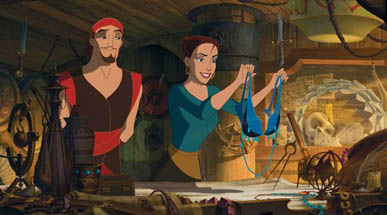 Directed
by: Timothy Johnson (Antz) and
Patrick Gilmore
Directed
by: Timothy Johnson (Antz) and
Patrick Gilmore
Written by: John Logan
Music by: Harry-Gregson Williams
Production Started On: No word yet about when animation production
started exactly, but it was underway as of mid-2001
Released on: July 2,
2003 (though June 27, 2003 was long rumored)
Running Time: 86 minutes
Budget: $60 million plus about $30 million
in marketing expenses
U.S. Opening Weekend: $10 million
Box-Office: $26.29 million in the U.S.,
$49.1 million worldwide
  |
  |
  |
  |
  |
  |
 |
Sinbad the Sailor... Brad Pitt (after Russell Crowe dropped out)
Marina (formerly referred to as Margiana)... Catherine Zeta-Jones
Proteus... Joseph Fiennes
Eris, The Goddess of Chaos... Michelle Pfeiffer (replacing Christine
Baranski)
Kale, the first mate and navigator of Chimera, Sinbad's ship...
Dennis Haysbert
Rat, the rigger of Sinbad's crew... Adriano Giannini
Official Storyline:
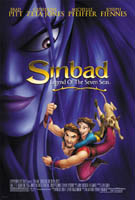 Sinbad,
the most daring and notorious rogue ever to sail the seven seas, has spent
his life asking for trouble, and trouble has finally answered... in a big
way. Framed for stealing one of the world's most priceless and powerful
treasures--the Book of Peace--Sinbad has one chance to find and return
the precious book or his best friend Proteus will die. Sinbad decides
not to take that chance and instead sets a course for the fun and sun of
the Fiji Islands.
Sinbad,
the most daring and notorious rogue ever to sail the seven seas, has spent
his life asking for trouble, and trouble has finally answered... in a big
way. Framed for stealing one of the world's most priceless and powerful
treasures--the Book of Peace--Sinbad has one chance to find and return
the precious book or his best friend Proteus will die. Sinbad decides
not to take that chance and instead sets a course for the fun and sun of
the Fiji Islands.
But not so fast.
Proteus' beautiful bethrothed, Marina, has stowed away, determined to
make sure that Sinbad fulfills his mission. Now the man who put the "bad"
in Sinbad is about to find out how bad bad can be. It's never a good thing
when Eris, the goddess of Chaos, has it out for yuo, and Eris lives to
her name--dispatching both monstruous creatures and the elements to do
battle with Sinbad along the way. There is even mutiny afoot--times four--when
Sinbad's loyal dog Spike switches allegiances. But those challenges don't
compare to one small but formidable woman named Marina.
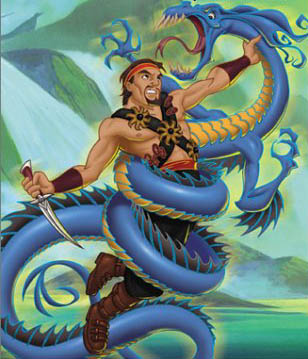 |
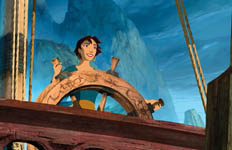 |
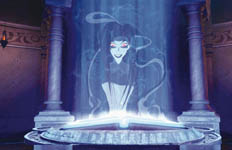 |
 |
![]() Jeffrey Katzenberg revealed
that this movie would be coming from DreamWorks' Glendale studio during
a press briefing held at Pacific Data Imaging (the creators of Antz
and Shrek) in Palo Alto, in February 2001.
Jeffrey Katzenberg revealed
that this movie would be coming from DreamWorks' Glendale studio during
a press briefing held at Pacific Data Imaging (the creators of Antz
and Shrek) in Palo Alto, in February 2001.
![]() Sinbad is another
2D/CG blend or animation, as seen in The
Prince of Egypt and The Road
To El Dorado.
Sinbad is another
2D/CG blend or animation, as seen in The
Prince of Egypt and The Road
To El Dorado.
![]() Co-director Patrick
Gilmore worked previously in video games.
Co-director Patrick
Gilmore worked previously in video games.
![]() Christine Baranski studied
with the great English voice expert Patsy Rodenberg, in order to lower
her register about an octave for the deep voice of Sinbad's villainess.
But the role eventually went to the more bankable Michelle Pfeiffer.
Christine Baranski studied
with the great English voice expert Patsy Rodenberg, in order to lower
her register about an octave for the deep voice of Sinbad's villainess.
But the role eventually went to the more bankable Michelle Pfeiffer.
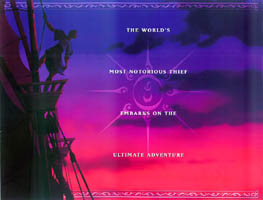
![]() A spokeswoman for DreamWorks confirmed in July 2001 that "we're not releasing
too much information about the film but, yes, Catherine [Zeta-Jones] and
Russell [Crowe] will front this movie."
A spokeswoman for DreamWorks confirmed in July 2001 that "we're not releasing
too much information about the film but, yes, Catherine [Zeta-Jones] and
Russell [Crowe] will front this movie."
![]() An August 2001 report
revealed that Sinbad was back in development: the film's script
was then being re-written to give it a more serious tone, instead of making
it a mere comedy. Part of the team working on Sinbad had been supposedly
fired or transferred to PDI, and the plan was to hire new animators with
lower wages. Based on the success of Shrek
and commercial failure of The Road
to El Dorado, as well as the lack of belief of Dreamworks in the
business potential of their risky piece Spirit:
Stallion of the Cimarron, Jeffrey Katzenberg would prefer to focus
on CG-features now and slow down on traditional animated films--which might
be true, since no other drawn project has been announced after Sinbad.
An August 2001 report
revealed that Sinbad was back in development: the film's script
was then being re-written to give it a more serious tone, instead of making
it a mere comedy. Part of the team working on Sinbad had been supposedly
fired or transferred to PDI, and the plan was to hire new animators with
lower wages. Based on the success of Shrek
and commercial failure of The Road
to El Dorado, as well as the lack of belief of Dreamworks in the
business potential of their risky piece Spirit:
Stallion of the Cimarron, Jeffrey Katzenberg would prefer to focus
on CG-features now and slow down on traditional animated films--which might
be true, since no other drawn project has been announced after Sinbad.
![]() Rumours in late 2001
stated that Brad Pitt took over the lead role from Russel Crowe, who could
not make himself available for this project and gave Dreamworks Animation
a bit of a hard time about it. Reportedly, the studio liked the way Brad's
voice tests went and decided to cast him as Sinbad. Brad Pitt was officially
confirmed in March 2002 in the title role, and the reason given for Russell
Crowe bowing out was "commitments to The Long Green Shore."
Rumours in late 2001
stated that Brad Pitt took over the lead role from Russel Crowe, who could
not make himself available for this project and gave Dreamworks Animation
a bit of a hard time about it. Reportedly, the studio liked the way Brad's
voice tests went and decided to cast him as Sinbad. Brad Pitt was officially
confirmed in March 2002 in the title role, and the reason given for Russell
Crowe bowing out was "commitments to The Long Green Shore."
![]() Jeffrey Katzenberg explained
at a Spirit: Stallion of
the Cimarron press junket in April 2002 that "next is Sinbad,
which Mireille [Soria, who produced Spirit with Max Howard] and
I are doing together and that will be another 'tradigital' animated movie
coming out this time next year, which is sort of taking the classic Sinbad
tales and putting it together in a really big adventure. Brad Pitt, Catherine
Zeta-Jones, Joe Fiennes, Michelle Pfeiffer – so we have an amazing voice
cast for that. It is an extraordinary adventure of gods and monsters:
the storytelling, the drama, the love story and the characterizations are
very sophisticated, closer to what you would see in an Indiana Jones movie
than in a typical 'cartoon.'"
Jeffrey Katzenberg explained
at a Spirit: Stallion of
the Cimarron press junket in April 2002 that "next is Sinbad,
which Mireille [Soria, who produced Spirit with Max Howard] and
I are doing together and that will be another 'tradigital' animated movie
coming out this time next year, which is sort of taking the classic Sinbad
tales and putting it together in a really big adventure. Brad Pitt, Catherine
Zeta-Jones, Joe Fiennes, Michelle Pfeiffer – so we have an amazing voice
cast for that. It is an extraordinary adventure of gods and monsters:
the storytelling, the drama, the love story and the characterizations are
very sophisticated, closer to what you would see in an Indiana Jones movie
than in a typical 'cartoon.'"
![]() The animation supervisor
of Spirit's title character commented at the same junket about his
work on Sinbad. When asked how the project was going, he replied,
"Fine, fun. Pirates and monsters. Sword-fighting." But less serious than
Spirit,
right? "Oy, yeah. Yeah. It's a lot less. Action, adventure, swordfights
and that sort of thing. You don't have to be so careful." Unlike
Spirit,
however, Baxter isn't the animation supervisor on Sinbad. "I'm actually
animating Sinbad, but I'm not supervising anything on that movie, I'm just
taking a backseat for a movie so I can rest," Baxter explained. "I'm animating
the main character of Sinbad, but I'm being supervised this time by a guy
that I was supervising on Spirit. We just traded places and it's
giving me a break. It's hard to work on something for a year and a half
– it just tires you out."
The animation supervisor
of Spirit's title character commented at the same junket about his
work on Sinbad. When asked how the project was going, he replied,
"Fine, fun. Pirates and monsters. Sword-fighting." But less serious than
Spirit,
right? "Oy, yeah. Yeah. It's a lot less. Action, adventure, swordfights
and that sort of thing. You don't have to be so careful." Unlike
Spirit,
however, Baxter isn't the animation supervisor on Sinbad. "I'm actually
animating Sinbad, but I'm not supervising anything on that movie, I'm just
taking a backseat for a movie so I can rest," Baxter explained. "I'm animating
the main character of Sinbad, but I'm being supervised this time by a guy
that I was supervising on Spirit. We just traded places and it's
giving me a break. It's hard to work on something for a year and a half
– it just tires you out."
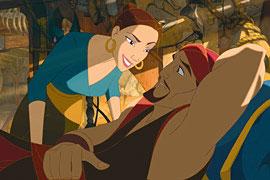
![]() While the exact details
of this adventure aren't known yet, it may be about the famous Arabian
sailor, Sinbad, and one of his seven great voyages. What puts that in question
is that two of the central characters, Eris and Proteus, didn't appear
in any of Sinbad's seven journeys: the Greek goddess of chaos, Eris, whose
magical golden 'Apple of Discord' has the ability to turn friends into
enemies when thrown in their midst; and Proteus, a Greek god who protected
Poseidon's seals who had powerful abilities of both prophecy and shapeshifting.
While the exact details
of this adventure aren't known yet, it may be about the famous Arabian
sailor, Sinbad, and one of his seven great voyages. What puts that in question
is that two of the central characters, Eris and Proteus, didn't appear
in any of Sinbad's seven journeys: the Greek goddess of chaos, Eris, whose
magical golden 'Apple of Discord' has the ability to turn friends into
enemies when thrown in their midst; and Proteus, a Greek god who protected
Poseidon's seals who had powerful abilities of both prophecy and shapeshifting.
![]() In June 2002, DreamWorks
awarded Hasbro Inc. the main toy license for Sinbad: Legend of the Seven
Seas. It will be a part of the GI Joe action figure brand, one of only
a few characters that have been attached to the brand, the companies said
in a statement released Sunday. Hasbro also will have rights to all clothing,
vehicles, environments, play sets and other accessories related to the
action figures. "It was a natural fit for what we are doing in this
segment of GI Joe," Darryl DePriest, director of marketing for the GI Joe
brand, said. DreamWorks expects to license products for the movie to about
20 companies, said Brad Globe, who oversees DreamWorks' consumer products.
In June 2002, DreamWorks
awarded Hasbro Inc. the main toy license for Sinbad: Legend of the Seven
Seas. It will be a part of the GI Joe action figure brand, one of only
a few characters that have been attached to the brand, the companies said
in a statement released Sunday. Hasbro also will have rights to all clothing,
vehicles, environments, play sets and other accessories related to the
action figures. "It was a natural fit for what we are doing in this
segment of GI Joe," Darryl DePriest, director of marketing for the GI Joe
brand, said. DreamWorks expects to license products for the movie to about
20 companies, said Brad Globe, who oversees DreamWorks' consumer products.
![]() That same month, first
pictures from Sinbad premiered on a flyer distributed in very small
quantities at the 2002 Licensing Show in New York City.
That same month, first
pictures from Sinbad premiered on a flyer distributed in very small
quantities at the 2002 Licensing Show in New York City.
![]() Apparently seeing more potential of reaching a larger audience after school's
out in June 2002, DreamWorks had pushed Sinbad back several weeks
from May 23 to July 2nd, 2003, to take advantage of a four-day holiday
weekend, while also offering a family-friendly alternative to the juggernaut
that will undoubtedly be Terminator 3: Rise of the Machines. However,
in October 2002, the studio reportedly decided against this approach and
bumped the movie up a week to June 27th, away from the challenging Independence
Day weekend, but closer to competition like Rugrats Go Wild. An
indecisive DreamWorks ended up sticking to the July 2nd slot.
Apparently seeing more potential of reaching a larger audience after school's
out in June 2002, DreamWorks had pushed Sinbad back several weeks
from May 23 to July 2nd, 2003, to take advantage of a four-day holiday
weekend, while also offering a family-friendly alternative to the juggernaut
that will undoubtedly be Terminator 3: Rise of the Machines. However,
in October 2002, the studio reportedly decided against this approach and
bumped the movie up a week to June 27th, away from the challenging Independence
Day weekend, but closer to competition like Rugrats Go Wild. An
indecisive DreamWorks ended up sticking to the July 2nd slot.
![]() Jeffrey Katzenberg revealed
in October 2002 that "for 10 years I've dreamed of getting Brad Pitt to
play one of these great action-adventure leading-men characters. He's so
charismatic; he's got such a great sense of humor. It's unlike any role
he's done before. There are few titles in the world when you say instantly
bring to mind action, adventure, fun. And Sinbad is it."
Jeffrey Katzenberg revealed
in October 2002 that "for 10 years I've dreamed of getting Brad Pitt to
play one of these great action-adventure leading-men characters. He's so
charismatic; he's got such a great sense of humor. It's unlike any role
he's done before. There are few titles in the world when you say instantly
bring to mind action, adventure, fun. And Sinbad is it."

![]() Throughout the making
of the movie, Katzenberg says, "we've seen Brad stark clean--complete and
total nothing on his face--to this amazing beard to now looking like Sinbad."
He adds that animators did try to capture Pitt's "million-dollar smile,"
but they didn't copy his facial hair. "Maybe he was inspired by Sinbad?"
We meet Sinbad when he's "Brad's age" (38), and he looks that way from
start to finish. "Brad actually has an option. Every day he can get up
and decide to grow a beard or be cleanshaven. Sinbad doesn't have that
luxury. He is too busy fighting monsters."
Throughout the making
of the movie, Katzenberg says, "we've seen Brad stark clean--complete and
total nothing on his face--to this amazing beard to now looking like Sinbad."
He adds that animators did try to capture Pitt's "million-dollar smile,"
but they didn't copy his facial hair. "Maybe he was inspired by Sinbad?"
We meet Sinbad when he's "Brad's age" (38), and he looks that way from
start to finish. "Brad actually has an option. Every day he can get up
and decide to grow a beard or be cleanshaven. Sinbad doesn't have that
luxury. He is too busy fighting monsters."
![]() Director Tim Johnson
revealed in a December 2002 interview that the face of the goddess Eris
is being drawn by hand, while computer engineers are creating a body of
swirling, ethereal mist and light. "In 10 years, computers have made the
animation toolbox explode. We have gone from a screwdriver and a hammer
to a 500-piece garage mechanic's set. There is nothing we can imagine that
is out of reach now."
Director Tim Johnson
revealed in a December 2002 interview that the face of the goddess Eris
is being drawn by hand, while computer engineers are creating a body of
swirling, ethereal mist and light. "In 10 years, computers have made the
animation toolbox explode. We have gone from a screwdriver and a hammer
to a 500-piece garage mechanic's set. There is nothing we can imagine that
is out of reach now."
![]() Jim
Hill has heard in January 2003 "from a variety of sources that folks
over at that studio aren't taking much pleasure in Treasure
Planet's difficulties at the domestic box office. Why for? Because
Dreamworks' next traditionally animated film has been described as 'Treasure
Planet without the flying pirate ships.' Which is why I hear that Dreamworks
execs are now desperately casting about for a bold new ad campaign to help
sell this picture. The initial teaser
poster features a silhouette of Sinbad hanging off of the mast of his
ship. Which bears a striking resemblance to the final version of the Treasure
Planet poster that Disney's marketing staff created for that movie.
Dreamworks execs are reportedly worried that--if the posters for these
two pictures actually look the same--moviegoers may end up confusing the
two movies." Indeed, Jeffrey Katzenberg commented a couple of weeks later
that "our film is galaxies away from Treasure Planet."
Jim
Hill has heard in January 2003 "from a variety of sources that folks
over at that studio aren't taking much pleasure in Treasure
Planet's difficulties at the domestic box office. Why for? Because
Dreamworks' next traditionally animated film has been described as 'Treasure
Planet without the flying pirate ships.' Which is why I hear that Dreamworks
execs are now desperately casting about for a bold new ad campaign to help
sell this picture. The initial teaser
poster features a silhouette of Sinbad hanging off of the mast of his
ship. Which bears a striking resemblance to the final version of the Treasure
Planet poster that Disney's marketing staff created for that movie.
Dreamworks execs are reportedly worried that--if the posters for these
two pictures actually look the same--moviegoers may end up confusing the
two movies." Indeed, Jeffrey Katzenberg commented a couple of weeks later
that "our film is galaxies away from Treasure Planet."
![]() Jeffrey Katzenberg isn't
throwing in the pencil on traditional animation yet, even if his next five
animated films after Sinbad are either computerized or stop-motion.
"It's disingenuous to blame the technique for any failure. It's bad stories
not told well. It's like saying a novelist had a bad book because it was
typed on a laptop instead of written longhand."
Jeffrey Katzenberg isn't
throwing in the pencil on traditional animation yet, even if his next five
animated films after Sinbad are either computerized or stop-motion.
"It's disingenuous to blame the technique for any failure. It's bad stories
not told well. It's like saying a novelist had a bad book because it was
typed on a laptop instead of written longhand."
![]() 'Milo' wrote at the
DreamWorks
SKG Fansite Talkback in February 2003 that he saw "a preliminary version
of this movie over the weekend. The music wasn't final, and the animation
wasn't done (lots of rough pencil-sketched characters, and stationary backgrounds).
It is a very good show; my kids enjoyed it quite a lot, too, and are looking
forward to the final cut of the movie. There are no characters breaking
out into song, and I really don't see a place for Spirit's
type of song (it worked because the main characters didn't speak, if you
ask me). Overall, a really solid picture from Dreamworks. We all thoroughly
enjoyed ourselves."
'Milo' wrote at the
DreamWorks
SKG Fansite Talkback in February 2003 that he saw "a preliminary version
of this movie over the weekend. The music wasn't final, and the animation
wasn't done (lots of rough pencil-sketched characters, and stationary backgrounds).
It is a very good show; my kids enjoyed it quite a lot, too, and are looking
forward to the final cut of the movie. There are no characters breaking
out into song, and I really don't see a place for Spirit's
type of song (it worked because the main characters didn't speak, if you
ask me). Overall, a really solid picture from Dreamworks. We all thoroughly
enjoyed ourselves."
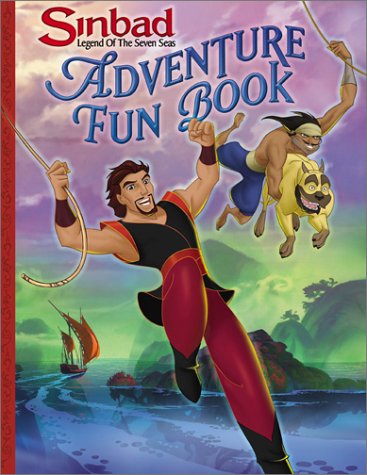
![]() Four months before
the movie's release, still no teaser trailer or poster had been released
to the public... 'Newcomb' stated at the Animation
Nation forum that "the film has been testing poorly, and while the
artwork is amazing, the story is a mess and marketing at Dreamworks is
busy retooling their approach to the film to focus on the 'stars' instead
of the story, or lack of one. They're particularly nervous after Treasure
Planet and their horse
movie both failed at the box office." A first trailer was finally released
on April 16, 2003, less than three months before Sinbad's theatrical
release!
Four months before
the movie's release, still no teaser trailer or poster had been released
to the public... 'Newcomb' stated at the Animation
Nation forum that "the film has been testing poorly, and while the
artwork is amazing, the story is a mess and marketing at Dreamworks is
busy retooling their approach to the film to focus on the 'stars' instead
of the story, or lack of one. They're particularly nervous after Treasure
Planet and their horse
movie both failed at the box office." A first trailer was finally released
on April 16, 2003, less than three months before Sinbad's theatrical
release!
![]() Michelle Pfeiffer commented
that her character Eris "is very amused by [Sinbad] and she toys with him,
sort of like a cat and a mouse. She finds him very intriguing and a challenge--she
doesn't really want to kill him, just torture him a little bit!"
Michelle Pfeiffer commented
that her character Eris "is very amused by [Sinbad] and she toys with him,
sort of like a cat and a mouse. She finds him very intriguing and a challenge--she
doesn't really want to kill him, just torture him a little bit!"
![]() Dennis Haysbert, who
voices the character Kale, commented that his character fills many functions
in the story. "Kale is the ultimate warrior. He's also Sinbad's best friend
and confidant and conscience. He's also a spiritual leader of the crew."
Haysbert recorded his lines alone and said he used a slightly different
version of his normal speaking voice. "I just gave it a little accent."
Haysbert added that voice acting gave him more freedom than any role he's
played. "It's the most open and freeing acting there is. You can do anything
you want, as long as the voice comes out right. Whatever machination you
have to go through to bring that voice out works."
Dennis Haysbert, who
voices the character Kale, commented that his character fills many functions
in the story. "Kale is the ultimate warrior. He's also Sinbad's best friend
and confidant and conscience. He's also a spiritual leader of the crew."
Haysbert recorded his lines alone and said he used a slightly different
version of his normal speaking voice. "I just gave it a little accent."
Haysbert added that voice acting gave him more freedom than any role he's
played. "It's the most open and freeing acting there is. You can do anything
you want, as long as the voice comes out right. Whatever machination you
have to go through to bring that voice out works."
![]() "What we've tried to
do is to take inspiration from the wealth of Sinbad mythology and to create
an exciting story using the classic elements that have been part of that
mythology for thousands of years," Jeffrey Katzenberg says. "One of the
most exciting things about making animated movies is that ability to take
the audience to a place of pure imagination, and this is as breathtaking
as any movie we've made at the studio today."
"What we've tried to
do is to take inspiration from the wealth of Sinbad mythology and to create
an exciting story using the classic elements that have been part of that
mythology for thousands of years," Jeffrey Katzenberg says. "One of the
most exciting things about making animated movies is that ability to take
the audience to a place of pure imagination, and this is as breathtaking
as any movie we've made at the studio today."
![]() Composer Harry Gregson-Williams
commented that "ultimately, Sinbad: Legend of the Seven Seas is
a love story. And, for me, the challenge of scoring an animated movie is
forgetting we’re talking about two drawings falling in love--just like
I had to forget that Antz
was about insects and Chicken
Run was about poultry. 'Honest' might be a strange word to use
in this context, but if you try to fool the audience musically, they won't
believe you. What you want is to be plunged into a world you can believe
in so you can invest your emotions in the characters. That's why there's
no tinkly cartoon music to remind you that it's really Brad Pitt in a sound
booth and not Sinbad in a ship. Shrek
was so irreverent. The score was as over-the-top as the characters. Sinbad
is also set in a fantastic world, but the character development and wide
emotional arc are unusual for animation. Even how it looks is different--a
hybrid of traditional and more contemporary techniques. The music had to
mirror the emphasis on character and the mix of classic and modern. At
its core, yes, it’s an orchestral score, but there are overtones of other
elements throughout, such as ethnic--particularly Middle Eastern--textures,
percussion, and flutes. Early in the film, Sinbad is a bit of an anti-hero.
A bit of a loser, a thief, self-obsessed. But then he transforms into a
noble hero. There are many ways of translating the heroic to the scoring
stage--including a bank of 12 French horns."
Composer Harry Gregson-Williams
commented that "ultimately, Sinbad: Legend of the Seven Seas is
a love story. And, for me, the challenge of scoring an animated movie is
forgetting we’re talking about two drawings falling in love--just like
I had to forget that Antz
was about insects and Chicken
Run was about poultry. 'Honest' might be a strange word to use
in this context, but if you try to fool the audience musically, they won't
believe you. What you want is to be plunged into a world you can believe
in so you can invest your emotions in the characters. That's why there's
no tinkly cartoon music to remind you that it's really Brad Pitt in a sound
booth and not Sinbad in a ship. Shrek
was so irreverent. The score was as over-the-top as the characters. Sinbad
is also set in a fantastic world, but the character development and wide
emotional arc are unusual for animation. Even how it looks is different--a
hybrid of traditional and more contemporary techniques. The music had to
mirror the emphasis on character and the mix of classic and modern. At
its core, yes, it’s an orchestral score, but there are overtones of other
elements throughout, such as ethnic--particularly Middle Eastern--textures,
percussion, and flutes. Early in the film, Sinbad is a bit of an anti-hero.
A bit of a loser, a thief, self-obsessed. But then he transforms into a
noble hero. There are many ways of translating the heroic to the scoring
stage--including a bank of 12 French horns."
![]() Jim Hill revealed in
May 2003 that DreamWorks was waiting to see how well Sinbad does
before it actually greenlights production of yet another traditionally
animated feature.
Jim Hill revealed in
May 2003 that DreamWorks was waiting to see how well Sinbad does
before it actually greenlights production of yet another traditionally
animated feature.
![]() As animation chief,
first at Disney and now at his own studio, Jeffrey Katzenberg has been
talking and negotiating with cartoon animals for two decades. "Animals
can talk in animated films whenever they want to. If they don't it probably
means they had tough agents," jokes Katzenberg in a June 2003 interview.
"For Sinbad we wanted a whole different kind of reality. It's meant
to be a fun adventure that the audience sees from a more real point of
view. It's not a world of talking fairytale creatures or a barnyard of
talking animals," says Katzenberg, who nixed the idea of talking equines
in Spirit:
Stallion of the Cimarron, DreamWorks' movie from last year. "It's
always arbitrary when we decide whether animals will talk or not but once
the rules are set you just don't deviate. Like the horses in Spirit,
Spike [the dog] talks without actually talking. If the writers, animators
and directors do their jobs, children know what these characters are thinking."
As animation chief,
first at Disney and now at his own studio, Jeffrey Katzenberg has been
talking and negotiating with cartoon animals for two decades. "Animals
can talk in animated films whenever they want to. If they don't it probably
means they had tough agents," jokes Katzenberg in a June 2003 interview.
"For Sinbad we wanted a whole different kind of reality. It's meant
to be a fun adventure that the audience sees from a more real point of
view. It's not a world of talking fairytale creatures or a barnyard of
talking animals," says Katzenberg, who nixed the idea of talking equines
in Spirit:
Stallion of the Cimarron, DreamWorks' movie from last year. "It's
always arbitrary when we decide whether animals will talk or not but once
the rules are set you just don't deviate. Like the horses in Spirit,
Spike [the dog] talks without actually talking. If the writers, animators
and directors do their jobs, children know what these characters are thinking."

![]() Writer John Logan stated in a recent interview that "for me, the entire
Sinbad
story could be summed up in two words: Ray Harryhausen." So it is especially
interesting to hear what the master animator and visual effects legend
behind such classics as The 7th Voyage of Sinbad and Jason and
the Argonauts had to say about the DreamWorks movie. "Due to my generation,
I'm from a different world from your world, but at first it was a little
bit of a shock to see such a stylized film, but when you get used to it,
it can be magnificent," the 82-year-old commented after watching the July
2 movie during a recent visit at the DreamWorks Animation campus in Glendale,
CA. "I thought it was beautifully done, and all of those subtle expressions
in the film, I thought were most impressive. I was raised with the traditional
Disney films, so to see such a heavily styled Sinbad was a bit of a shock
at first. The designs were magnificent... most impressive visuals... particularly
that city that changed. To see it on the big screen was magnificent." When
Dreamworks animator Frank Gladstone asked if there were some signature
Harryhausen moments in our film, Ray reportedly laughed and said: "There
were one or two Harryhausen moments in there. I'm not sure how many tentacles
the Sea Monster had. The set pieces and water effects were magnificent.
Almost looked like the parting of the Red Sea. Sometimes the sound effects
get a little heavy, but I can see where that's necessary."
Writer John Logan stated in a recent interview that "for me, the entire
Sinbad
story could be summed up in two words: Ray Harryhausen." So it is especially
interesting to hear what the master animator and visual effects legend
behind such classics as The 7th Voyage of Sinbad and Jason and
the Argonauts had to say about the DreamWorks movie. "Due to my generation,
I'm from a different world from your world, but at first it was a little
bit of a shock to see such a stylized film, but when you get used to it,
it can be magnificent," the 82-year-old commented after watching the July
2 movie during a recent visit at the DreamWorks Animation campus in Glendale,
CA. "I thought it was beautifully done, and all of those subtle expressions
in the film, I thought were most impressive. I was raised with the traditional
Disney films, so to see such a heavily styled Sinbad was a bit of a shock
at first. The designs were magnificent... most impressive visuals... particularly
that city that changed. To see it on the big screen was magnificent." When
Dreamworks animator Frank Gladstone asked if there were some signature
Harryhausen moments in our film, Ray reportedly laughed and said: "There
were one or two Harryhausen moments in there. I'm not sure how many tentacles
the Sea Monster had. The set pieces and water effects were magnificent.
Almost looked like the parting of the Red Sea. Sometimes the sound effects
get a little heavy, but I can see where that's necessary."
![]() While some suggested
that Sinbad failed at the box office because of its traditional
look, most analysts agreed that besides the fact that animated action flicks
generally don't fare well and kids prefer cartoons starring animals, Sinbad
was too boy-centric, its promotion relied too heavily on big name voice
actors that the core audience did not care about, and the trailers did
not entice any audience to go see the movie.
While some suggested
that Sinbad failed at the box office because of its traditional
look, most analysts agreed that besides the fact that animated action flicks
generally don't fare well and kids prefer cartoons starring animals, Sinbad
was too boy-centric, its promotion relied too heavily on big name voice
actors that the core audience did not care about, and the trailers did
not entice any audience to go see the movie.
![]() The problem with Sinbad,
like Treasure Planet, may lie more in the evidently flawed strategy
that many large studios embarked on several years ago to produce animated
action-oriented adventure movies to attract boys, said Jerry
Beck, an animation historian. "Almost all these movies have failed."
DreamWorks' Ann Daly also pointed out that the only animated movies (whether
hand-drawn or computer-generated) that have done well recently are comedies,
including Finding
Nemo and last summer's hand-drawn Lilo
& Stitch from Disney. Regardless, DreamWorks spokeswoman
Terry Press stated in September 2003 that "until audiences show some affection
for 2-D, we're not going to get back into it."
The problem with Sinbad,
like Treasure Planet, may lie more in the evidently flawed strategy
that many large studios embarked on several years ago to produce animated
action-oriented adventure movies to attract boys, said Jerry
Beck, an animation historian. "Almost all these movies have failed."
DreamWorks' Ann Daly also pointed out that the only animated movies (whether
hand-drawn or computer-generated) that have done well recently are comedies,
including Finding
Nemo and last summer's hand-drawn Lilo
& Stitch from Disney. Regardless, DreamWorks spokeswoman
Terry Press stated in September 2003 that "until audiences show some affection
for 2-D, we're not going to get back into it."
![]() "We are extremely disappointed,"
said Ann Daly, the head of animation for DreamWorks, two weeks after the
film's very weak opening, noting that Sinbad would be the studio's
last traditionally drawn film. From now on, DreamWorks will use computers
to animate its movies. Even Jeffrey Katzenberg conceded that the art form
on which he made his reputation may be obsolete. "I think the idea of a
traditional story being told using traditional animation is likely a thing
of the past," he admitted. Among other factors, Katzenberg said, fast-evolving
technology is making it easier to create images that a few years ago could
only be drawn by hand.
"We are extremely disappointed,"
said Ann Daly, the head of animation for DreamWorks, two weeks after the
film's very weak opening, noting that Sinbad would be the studio's
last traditionally drawn film. From now on, DreamWorks will use computers
to animate its movies. Even Jeffrey Katzenberg conceded that the art form
on which he made his reputation may be obsolete. "I think the idea of a
traditional story being told using traditional animation is likely a thing
of the past," he admitted. Among other factors, Katzenberg said, fast-evolving
technology is making it easier to create images that a few years ago could
only be drawn by hand.
![]() DreamWorks executives
declined to say how much Sinbad cost. Some industry people have
conservatively estimated that DreamWorks spent $70 million (not including
marketing expenses), although the comparable Treasure
Planet cost Disney about $140 million, according to animation industry
executives. Ann Daly said that whatever the losses on Sinbad, they
would not be financially devastating.
DreamWorks executives
declined to say how much Sinbad cost. Some industry people have
conservatively estimated that DreamWorks spent $70 million (not including
marketing expenses), although the comparable Treasure
Planet cost Disney about $140 million, according to animation industry
executives. Ann Daly said that whatever the losses on Sinbad, they
would not be financially devastating.
 |
 |
 |
 |
INTERVIEW WITH DIRECTORS PATRICK GILMORE & TIM JOHNSON
The following interview took place at the DreamWorks
Animation Studios in Glendale, CA on June 13, 2003 at 10:00am in front
of a select few online and offline reporters. Animated-Movies.com
transcribed the following interview.
Q: When did this all start for you? Was it a Sinbad movie from your conception?
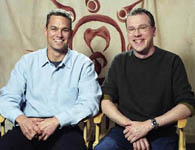 Patrick
Gilmore: I came on in September of 1999, just about four years ago.
Patrick
Gilmore: I came on in September of 1999, just about four years ago.
Tim Johnson: ... another millenium ago!
Patrick Gilmore: And it was Sinbad. I had been working on video games for a long time, and working in some form or another with Jeffrey [Katzenberg], and doing a lot of game products that heavily featured animation. Jeffrey and I had been talking for almost two years and he called me one day, and said,"Look, I have something I think right up your alley. It's Sinbad." And I said, "Where do I sign?" It's the story of Damon and Pythias, which is a Greek mythology that is the thread that ties all of our great Sinbad adventures together. It felt like such a great thematic, strong, interesting spine, the story of two friends, one who puts his life on the line for the other, and then he sets the other guy free and asks what he's gonna do. And I just thought that that was really a great, strong, dramatic, fun story. I was in from the moment he said "Go!"
Tim Johnson: I directed Antz,
up north at PDI, and [was given] the opportunity to come down here and
work in my original love, with 2D artists. I started as a 2D animator,
so while I love and will return to CG animation,
the opportunity to get involved in Sinbad, an action adventure on
this scale--to try to modernize something as classic as that--and especially
to work closely with 2D artists, who I think bring a level of emotional
realism to things which is far beyond what computers can do.
Q: Patrick, did your gaming experience have a lot to do with choreographing the action? It was very good action, and the fight scenes were wonderful!
Patrick Gilmore: I think that's part of the reason why Jeffrey was interested in the beginning, because the games are very action-driven. And certainly when you look at the action sequences, there is a lot of that type of adrenaline running through them, but the dictates of telling a story are quite different from the dictates of creating a game. We're lucky because they're sort of similar worlds. I think this was the first film which was modeled in animatics 100% from start to finish, which is very much like designing levels and creating environments for games.
Tim Johnson: ... and animatics are fully 3D environments. So
even though it's a 2D film, everything was built on the computer for the
camera moves to be figured out. And then later, we would decide whether
it needed a 3-dimensional approach or a 2-dimensional approach.

Patrick Gilmore: And it also allowed us to do something that's
done very rarely in animated films which is to shoot coverage if you will.
If you look at a film like Gladiator or any live action film--and
basically a lot of those battle sequences are a product of a warehouse
of footage that gets shot on the set--and we sort of adopted that approach.
Normally I think, an animated film is very linear, you go from story to
layout, and then you start to plan your shot, and you really don't create
much more than what ends up in the film. But what we did in that sequence,
like the arrival when they reach the end of the world, is we sort of made
the ship go to the edge and go over the edge and then shot from every angle
we could think of, and handed it all to our editor Tom Finan, and say:
"Cut together the best action sequence you possibly can, we've given you
as many dynamic shots as we can." And then he is the guy who sort of became
the architect of what that scene became. And from that point forward, we
had our shot list and created all the footage, so it was a really terrific
way to work! I think there is a cross-over with games--as a short answer
to your question--but there is enough difference that this was its own
animal.
Q: Can you talk about casting for voices? I know Pixar usually takes a scene from another movie and then match it to the voice of the character to see if that person would be right. How do you match the voices? And do you ever think of not having a big star? Because truthfully, for the first 10 minutes of Sinbad, I kept on thinking: "That doesn't look anything like Brad Pitt!" But then after that I got into it...
Tim Johnson: You do have to realize that with an animated film,
you're not getting the dazzling smile and the million-dollar hairdo. You're
getting the voice. But the other thing you realize really quickly--having
worked with a wide range of different levels of talent and acting--is these
people are famous for a really good reason. There's something about their
ability to speak a line that makes us pay attention and feel a more universal
emotional connection with that line. So it's not merely stunt casting to
be able to grab somebody like Brad Pitt and put him in the role of Sinbad.
It really is--and we did listen to a lot of voices--[about whether] you
just paid attention to him, you believed him, you wanted to go on the ride
with him. There's a charisma that extends beyond the blond hair and blue
eyes. It's really amazing what a great actor does purely with [his] voice.
I don't know what Pixar's process is [but] ours is to actually put the
voices on CD or audio tapes and listen to them without any visual reference
at all, and let our minds do the experiment of placing their voice in the
design of our characters. And when you know that they worked without any
help of their faces, you know that they'll be a terrific drive for an animated
character.
Q: Do they come in to read the lines? Do they audition?
Tim Johnson: No, not at this level. We do a big presentation to them, especially to the four or five major stars. And we have determined pretty exactingly how we're gonna work with their voice by the time we go and pitch it.
Patrick Gilmore: Our casting department usually makes a tape,
sometimes with 15 or 20 people on it, and we sit and listen to it, and
you sit and listen to the voice, and sometimes for a film like Sinbad,
if it's slightly urban or slightly accented or takes you to another place,
then it didn't really fit. And we don't know who they are, and they come
back to us and say, "That was Ed Norton from X, Y or Z
or it was this person or it was that person," so for us it's like a blind
taste test of voices. We just sit there and listen and say, "Okay, which
one of these feels most like the character we want to put in our movie."
And in this case, we heard Brad [Pitt], and Jeffrey [Katzenberg] heard
Brad and everybody sort of said: "This guy is casual and fun, he's easygoing,
he sounds physical but still has that youthful quality that Sinbad needs
to have."
Q: Did you recognize his voice?
Patrick Gilmore: Well, it's a game you play. [laughter] Half
the time you know the movie, half the time you know the actor, but we try
to take that out of the process and just try to listen to the voice.
Q: So what did the kids you brought think of the movie [at the showing last night]?
Patrick Gilmore: It was great, we all went out to dinner afterwards
and the kids loved it, they were over the moon. They didn't shut up about
it! They kept on going and going and going. I have to say that this was
a group of dads that I literally met when I started working on Sinbad,
because we're all in the Indian Guides together, and we've been talking
about it for three years, [but] they knew absolutely nothing about it.
And it was really the dads' reaction that made me the most proud because
they were universally blown away. They were thrilled, surprised, delighted,
and they all wanted to go back and see it with the rest of their family.
Q: [Sinbad's writer] John Logan said he wasn't completely
comfortable with the Book of Peace. Whose idea was it?

Tim Johnson: Nobody was [comfortable with it]. It's a tough
one. Boy...
Patrick Gilmore: It was the Book of Fate originally. We took a long time. At one point the book was blank and when you opened it it would reveal who the next King was, and it was a tool that was used in delineating who would be the next ruler. And at one point it was not magic at all, it was more like the Declaration of Independence, it was sort of the rule of law that was important because people had just agreed to place this value on it. And I think what happened was, at some point during the production, Michelle Pfeiffer cracked open Eris for us, and made her a real formidable and interesting character in spite of how powerful she was, she was really invested in what was going on. And we realized that what we had was the story of a normal mortal human being who was defying a God. And the Book of Peace, as this instrument of protection from the Goddess of Chaos, sort of became what it was today, it became this magical object that was the instrument of protection against chaos.
Tim Johnson: At the same time, we had prologues that went on
ad nauseum about the Book of Peace. [laughter] "And The Magical Powers
Extended Back And Then..." [snore sound].
Q: Since nobody was comfortable with it in the beginning, who introduced it? Jeffrey?
Patrick Gilmore: The Book of Fate was part of the story from the very beginning. And it became other objects at different times, and ultimately we acknowledged it for what it was. It needs to be magical, it sort of needs to be simple, we started talking about the Arc of the Covenant. One line [describes it], "The army that carries the Arc before it is invincible," and we didnt' want to make too much out of it, we just wanted to make it simple and clear what it was. But we wanted to make the story about the characters as opposed to about some object.
Tim Johnson: We did want magic in the picture though, and that's
why it ultimately didn't stay the Declaration of Independence, as Patrick
describes it. We sort of chanted magic and Gods and monsters, that's the
world we were going to visit, an alternate history a thousand years ago.
While it's definitely a MacGuffin,
it's a crown jewel to be stolen to frame Sinbad. I think it adds a tone
to the picture, you just get the sense of a realm in which the balance
between the Gods and Man and monsters is an interesting and delicate balance.
Q: Can you talk about the cityscape, and what you used for Syracuse specifically? And also about Tartarus?
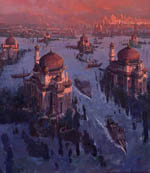 Patrick
Gilmore: Basically the idea was that we wanted to make our Sinbad
a purely fantastic world. So the influences of Syracuse come from the Far
East, from the Arabian world but also from the Mediterranean. From the
blue
mosque in Constantinople, Greece, Venice, France, there are a couple
of palaces, the Alhambra in Spain,
and it was all just looking at the world of the Mediterranean, the Ottoman
Empire, all of these things, and trying to bring elements of all the different
architectures. You may have a dome-style that feels slightly Arabian, you
may have a window-style that feels sort of Venetian, you may have a streetscape
or a cityscape that looks a little bit like Constantinople. But the goal
was to borrow elements of each of these and combine them into a world that
felt like it could have existed in a fantasy past, but it was magical.
It was bigger and more fanciful.
Patrick
Gilmore: Basically the idea was that we wanted to make our Sinbad
a purely fantastic world. So the influences of Syracuse come from the Far
East, from the Arabian world but also from the Mediterranean. From the
blue
mosque in Constantinople, Greece, Venice, France, there are a couple
of palaces, the Alhambra in Spain,
and it was all just looking at the world of the Mediterranean, the Ottoman
Empire, all of these things, and trying to bring elements of all the different
architectures. You may have a dome-style that feels slightly Arabian, you
may have a window-style that feels sort of Venetian, you may have a streetscape
or a cityscape that looks a little bit like Constantinople. But the goal
was to borrow elements of each of these and combine them into a world that
felt like it could have existed in a fantasy past, but it was magical.
It was bigger and more fanciful.
Q: Did you go anywhere?
Patrick Gilmore: Usually I think the productions do that. I remember
a meeting when one of the producers said: "We got our trip all planned,"
and Jeffrey said, "What are you talking about a trip? This is a fantasy
movie. Your trip is to Barnes & Nobles!" [laughter]
Q: How did you two work as a team of directors? Do you split what you do or do you collaborate on everything?
Tim Johnson: It's really essential to collaborate on everything
at the beginning. We become the checking balance for one another on story
points, and really heated but always pretty affable debates, which are
fun, and that's the guts of the storytelling: "What if we did this", "Well,
what about this?" But at a certain point, the harsh realities of production
kick in: 700+, 750 people, all of them needing some level of feedback before
they can continue the next step. Patrick and I were sewn at the hip, and
then through amazing surgery, removed from one another to go our own ways
and help just service the production. We became answering machines, and
literally your days are blocked out in comically small 5 or 10 minutes
increments, in which you feel like you're going "Yes!", "No!", "Yes!",
"Tomorrow!", "Blue!", "Five!" And we're really just helping people push
the film forward. But your primary job as a director with 700 people is
to make sure that all 700 people are making the same picture. So your responsibility
point is to make sure that the two of you are making the same picture.
Q: When you're sitting in the recording session with all these notable actors, how much directing do you really do?
Tim Johnson: It depends on the actor. They really need more help in some ways that when they've got a costume and make-up and a set and an actor across of them. Remove all that and you've got a microphone and a person in sweats and a baseball cap going: "Where am I again?"
Patrick Gilmore: Sometimes it's as simple as "How far away is the person I'm talking to?" Because they can either be 20 feet away, 5 feet away, and it's different.
 Tim
Johnson: And we're really workshopping, we talked about having the
mental image of Sinbad and then combining Brad Pitt and saying, "Alright,
that's it! He's the guy we wanted!" But it works both ways, you end up
discovering so much in the first three or four of your 12 or so recording
sessions with the lead that you make lots of changes. I mean, Brad took
anger and made it hysterical. Every time Sinbad was going "Ah!", "Oh",
[making noises]... that's genius! And so we found ways to let this utterly
competent adventurer become utterly juvenile, incompetent in the face of
these kind of conflicts. And he brought that and so much more to the role.
When you workshop a play, you write work down, you get it up there on stage,
you watch people read it, you realize what's flat and boring or not real,
you customize to the actor. It's very much that experience: listening very
hard to the actor and working with them to craft the character that really
feels significant and real. You get away with a lot in live action that
you don't get away with in animation. It's got to be extra real, because
it's fake.
Tim
Johnson: And we're really workshopping, we talked about having the
mental image of Sinbad and then combining Brad Pitt and saying, "Alright,
that's it! He's the guy we wanted!" But it works both ways, you end up
discovering so much in the first three or four of your 12 or so recording
sessions with the lead that you make lots of changes. I mean, Brad took
anger and made it hysterical. Every time Sinbad was going "Ah!", "Oh",
[making noises]... that's genius! And so we found ways to let this utterly
competent adventurer become utterly juvenile, incompetent in the face of
these kind of conflicts. And he brought that and so much more to the role.
When you workshop a play, you write work down, you get it up there on stage,
you watch people read it, you realize what's flat and boring or not real,
you customize to the actor. It's very much that experience: listening very
hard to the actor and working with them to craft the character that really
feels significant and real. You get away with a lot in live action that
you don't get away with in animation. It's got to be extra real, because
it's fake.
Q: What about Jim Cummings? What was it like working with him?
Tim Johnson: The man of many voices! I worked with Jim on Antz, and on a bunch of other projects. Jim has the ability to not only do a voice, but to be real in it. He's just amazing! He'll give you three takes of one line: one of them is sinister, and the other is humorous... With him especially you're really working quite a bit, because his dial is so wide, his range is so big.
Patrick Gilmore: He plays three characters. In a way two of the
characters he plays couldn't be further apart: on the one hand he plays
the old guy on the boat, Luka, who says [in a crackly old voice] "That's
it, time to go home" and "Come and get it ladies!", and on the other hand
he plays the lead delegate, who says [in a regal deep voice] "And we sentence
you to die." So you've got one guy who's sort of broad, and one guy who
is the foundation of every omnimous threat in the whole movie. And Tim
carries that off really brilliantly.
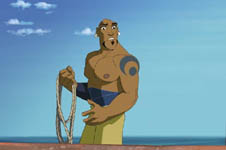
Tim Johnson: You know, one of the characters that's worth mentioning,
Dennis Haysbert, was a very small role as Kale. And at that first session
with him, the moral authority of that man's presence and voice made us
recraft and rewrite whole scenes so that Kale did become more of Sinbad's
big brother and conscience than he had ever been written. So there's a
great example of a discovery made in casting and recording that had a huge
influence--and beneficial one obviously--on the story.
Q: So when the characters evolved, are you're actually going back in the studio and re-recording?
Tim Johnson: Absolutely, and rewritting. Patrick and I would
come back from a recording session, and frequently John [Logan] would be
able to join us. But more often than not he would be back at his home in
Chicago and we would call John right away and go: "We just learned something.
When Brad did this scene, something kind of fell flat. We're gonna send
you a tape and we're gonna talk," and John would say: "I hear exactly what
you mean, this is the take we have to take." And that's really the joy
of this. Letting the film tell you a lot about where the real heart is,
and not feeling the pressure to force things into square pegs and round
holes.
Q: The music had a lot of that swashbuckling Erol Flynn quality. Did you pick the music?
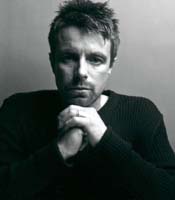 Tim
Johnson: Harry [Gregson-Williams],
who I worked with on Antz, he's such a genius!
He's so capable in everything musical. So we told him we wanted 21st century
action adventure. You go to Raiders of the Lost Arc and listen to
that kind of classic work and really put down the line for him to say:
"Give us something timeless, like a fantasy from a thousand years ago but
make it 21st century action adventure...."
Tim
Johnson: Harry [Gregson-Williams],
who I worked with on Antz, he's such a genius!
He's so capable in everything musical. So we told him we wanted 21st century
action adventure. You go to Raiders of the Lost Arc and listen to
that kind of classic work and really put down the line for him to say:
"Give us something timeless, like a fantasy from a thousand years ago but
make it 21st century action adventure...."
Patrick Gilmore: "... Okay, see ya!" [laughs] Part of the reason why Harry's great is, if you listen to Spy Game or any number of the movies that he's done, he's really gifted at creating a sound that sort of feels somewhat traditional, but then weaving in instruments and arrangements that are super contemporary. So we'd sit in his office and he'd say, "I want to play you this duduk" and it's this weird Middle Eastern instrument and he'll find a way to weave that into the composition so it doesn't feel too much of a throwback, doesn't feel too much like Erol Flynn, it does feel contemporary. If you listen to the score from this film, it's really amazing how thoroughly that's woven in.
Tim Johnson: You know, the score comes last, so he's composing directly to the actual cuts and pace of the show. And you frequently get the question: "What was it like to finally see your picture finished," and you lie and you say, "It was great!", because the fact is you've had beaten out of you. The freshness is gone. We've seen every shot in this film--and it's not exaggerating--2,000 times. But, the first time you hear original music composed for the piece... and especially Patrick and I had the great priviledge of going to the recording session in London at Abbey Road Studios where basically, you can burp and it sounds fantastic! [laughs] The room is just beautiful, acoustics, I think I can speak for both of us and say of the many highlights of the picture, many may equal but none exceeds sitting and hearing 80 pieces play Harry's score to our picture, and feeling a little bit like maybe we hadn't seen it before, and it was becoming new.
Patrick Gilmore: Very emotional...
Q: There were a few scenes that were slightly sexual...
Patrick Gilmore: Totally accidental! [laughs]
Q: ... How do you deal with sex and sexuality and sensuality in a
children's movie?
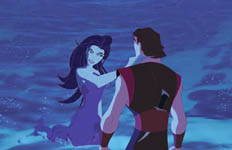
Tim Johnson: You have to be very aware of what you're dealing
with, and make sure that it works in a way that is dignified rather than
prurient. And I think that's really what we strove for. We tried making
Marina an independent, strong--and as a result of those qualities--sexy
woman. In fact she had long hair for a long time. We gave her a haircut
because we thought it gave her less of the traditional animated princess
look, and made her more strong and independent. I think that the challenge
was to show a little heat between the characters so that those people,
you know, adults and teens, could see a real passion in the characters,
but never be prurient, never be something that was just for lasciviousness,
but for the story. And frankly, I think that kids detect that attraction
but they're not that aware of the body language at that level. We tried
to skate that razor's edge to make it appeal to a broad audience without
ever making the adult sitting next to their child uncomfortable.
Q: How did you get away with the fanny shot then?
Tim Johnson: The butt shot? Well that's not quite sexual, that's pure comedy! [laughter] Every kid in the theater bursts into laughter when they see that.
Patrick Gilmore: I don't think anybody reads any sexuality into
that...
Q: Obviously there are crops of kids who are going to watch this film. What were the movies, the animated features that you saw when you were kids that made you want to make Sinbad?
Tim Johnson: Well I was an animator from the point that I could flip pages. It was the joke that people would fight for my text books at school because every single page could be flipped to see some stick figure throw a spear through the head of a teacher or something. [laughter] I was born in 1960 so you can go right through what Disney films and other animated features were released and just march through my favorites. 101 Dalmatians and The Jungle Book were huge and still continue to be hugely influential. Now that I have two little boys of my own, I'm sitting there glued to the screen. It's pure filmmaking. Everything about animated films is a pure celebration of creativity and filmmaking. [I'm] not trying to insult live action filmmakers, but my God, they turn on a camera and they get a picture! [laughter] Every single leaf on every tree, every vein on that leaf, every color has to be decided upon and labored lovingly over. And it's a joy to have loved animation growing up and now actually being able to do it.
Patrick Gilmore: The first film I ever saw in my life was Lady and the Tramp, and because it's the first film and because it's a great film, it had a huge impact on me. I remember just totally falling apart in the movie theater when the bloodhound gets run over in that movie. That began my love affair with movies and my love affair with animation. And I have to say some of the biggest influences--you know, you can look at the classics like Pinocchio which is a huge favorite of mine--but some of the biggest influences for me were that '90s renaissance of animation, when The Little Mermaid, Aladdin, Beauty and the Beast and The Lion King came out, when I feel like they took an old formula and updated it and found a way to contemporize animation. Those films, every one that I mentioned, were a revelation each in its own way for me.
Tim Johnson: Animation is an excuse to be thematic and old-fashioned
in a good way. It's a shame I think when movies aren't really about anything.
But with animation, you have an obligation to have something to say. It's
a chance for families and parents to discuss the decisions that characters
make in a story. I heard a great quote from actually, of all things, a
musician, who said, "Adults use stories for entertainment, but kids use
stories to live." And it's a great obligation and responsibility, and we
treasure it. And as parents ourselves, [we had] to make a film that tries
to say something positive. You have a chance when you're sending something
out to the popular culture to maybe be a touchstone for somebody. You cross
your fingers, do you job right? Maybe somebody will find themselves in
a tough situation, and say, "Well I've seen characters face tough situations
and maybe I'm 1% braver as a result."
INTERVIEW WITH SCREENWRITER JOHN LOGAN
The following interview took place at the DreamWorks
Animation Studios in Glendale, CA on June 13, 2003 at 9:30am in front of
a select few online and offline reporters, which Animated-Movies.com
had the priviledge of being part of. Latino
Review transcribed the following.
Q: What were some of your inspirations for the story of Sinbad?
 John
Logan: I would say that the entire Sinbad experience can be
summed up in two words: Ray Harryhausen. I grew up on those movies, and
I just loved them. I loved the look of them, the feel. They were fun, gaudy,
exciting, and swashbuckling. So when Jeffrey [Katzenberg] came to me and
asked if I wanted to write an animated movie, I said, "No, of course not.
I know nothing about animated movies, I know nothing about the process."
And he pitched the idea of doing Sinbad in the vein of Ray Harryhausen,
paying homage to that spirit of swashbuckling fun. And of course, I said
yes, because it sounded like such an exciting idea. So all the way along,
closest to my heart has been those Ray Harryhausen movies and trying to
capture that spirit. Certainly the other influences in terms of tone and
feeling were Errol Flynn, Douglas Fairbanks, and the Michael York of Three
Musketeers. Once again, all swashbuckling fun. And then, as a studious
writer, I said, "Well, if I'm going to do Sinbad, I have to read the Sinbad
story," assuming naively, that there was going to be a Sinbad story. The
Dreamworks people gave me ten volumes! There's the "Arabian Nights" Sinbad,
the Persian Sinbad, the Greek Sinbad, and the Roman version of Sinbad.
I realized he was a Homeric figure, like Ulysses, where people had told
myths about the "wandering seafarer" through the ages. So the process of
developing the story was about weeding through that material and trying
to get the essence of the character.
John
Logan: I would say that the entire Sinbad experience can be
summed up in two words: Ray Harryhausen. I grew up on those movies, and
I just loved them. I loved the look of them, the feel. They were fun, gaudy,
exciting, and swashbuckling. So when Jeffrey [Katzenberg] came to me and
asked if I wanted to write an animated movie, I said, "No, of course not.
I know nothing about animated movies, I know nothing about the process."
And he pitched the idea of doing Sinbad in the vein of Ray Harryhausen,
paying homage to that spirit of swashbuckling fun. And of course, I said
yes, because it sounded like such an exciting idea. So all the way along,
closest to my heart has been those Ray Harryhausen movies and trying to
capture that spirit. Certainly the other influences in terms of tone and
feeling were Errol Flynn, Douglas Fairbanks, and the Michael York of Three
Musketeers. Once again, all swashbuckling fun. And then, as a studious
writer, I said, "Well, if I'm going to do Sinbad, I have to read the Sinbad
story," assuming naively, that there was going to be a Sinbad story. The
Dreamworks people gave me ten volumes! There's the "Arabian Nights" Sinbad,
the Persian Sinbad, the Greek Sinbad, and the Roman version of Sinbad.
I realized he was a Homeric figure, like Ulysses, where people had told
myths about the "wandering seafarer" through the ages. So the process of
developing the story was about weeding through that material and trying
to get the essence of the character.
Q: It seemed that you used more of the Greek Sinbad.
John Logan: Yes. Very much. And frankly, I was still in Gladiator
mode, so I was ready for Greco-Roman. I knew that world. The Persian Sinbad
on the other hand, was a little bit too much work for me.
Q: Did you write it specifically with an animated movie in mind, such as stretching some of the physical boundaries in ways live action movies cannot?
John Logan: Actually, no. Initially, I wrote it as I would write
a live-action movie. I went through all of the same process. You start
with Aristotle, you understand rising and falling action, the arcs of the
characters, and I wrote it as I would write a live-action movie. And the
process of writing it, over the past four years, has been a process of
learning why an animated movie is not a live action movie. What was a coolest
about it, from my perspective, is that my experience has been working with
directors. And working with Patrick [Gilmore] and Tim [Johnson] was a great
experience. But there was something else about it that I'd never been through,
which is working with animators and story editors... people who are deeply
invested in the story, coming in with great ideas. So what I learned was
that the collaboration you can have with these amazing artists can help
the material in ways you never imagined. Directors can be very linear.
The focus is always on narrative. If the spine of the story is not correct,
no matter what it is, it's never going to work. But dealing with people
whose focus was visual, and not just what the ship looks like, but what
the world looks like, and what it feels like... was incredibly new for
me. And initially, I didn't know what to make of it. I thought, "Are they
trying to write the movie?" And little by little, my confidence level and
trust level in them grew one hundred percent, as theirs did with me. The
animators would say, "What do you think about this for Spike the dog? What
can we do with this?" And I would say, "Well, I like this, and I like that,
and here’s some opportunities." Or I would go to them, and say, "Let's
talk about the Sirens for a little bit. Here's how I imagine it." So it
became very give and take in a very healthy way. And it took me a while
to understand that process. Now, I'm such a pro at it. The best single
example in terms of what I learned, was Tartarus at the end of the movie.
Because it's very easy for a writer to write: "It's the realm of chaos.
The laws of physics don't apply. It’s like Escher meets Giger." And I'm
like, "Well, I've done my job. I'm so happy. They're going to love this."
And indeed they did love it. And then they asked, "Well, what does it actually
look like?" So they opened it up to all the animators, gave them the description,
told them how it was supposed to feel, and had them draw what it would
look like. And we went through two years of development on what the wasteland
area would be like. It was give and take every step of the way, with the
animators, me, Jeffrey, and the directors.
Q: Is the Book of Peace part of the Sinbad legend?
John Logan: No. It is, in Hollywood tradition, our "McGuffin."
I personally had problems with the Book of Peace because I didn't like
the theological aspects of it. There's a thin line between imaginative
and even supernatural, and theological. Theological makes me nervous, but
imaginative and supernatural, I think, is fabulous. The Book of Peace sits
on the fulcrum of that triangle rather uncomfortably.
Q: Can you talk about the relationships between the characters?
John Logan: The idea of personal redemption is a universal great
theme that dramatists have explored forever. And the thing that appealed
to me most, being a dramatist, was the Sinbad/Proteus relationship. I knew
it would be great to do Marina and Sinbad, it's Cary Grant/Katherine Hepburn,
that sort of bickering fun where they hate each other yet fall in love.
And I knew it would be very entertaining, which it was, but what I found
most compelling about the movie was the story of the two friends. What
would you give for friendship? And when you look in the mirror, as Sinbad
is finally forced to do metaphorically, who are you? Are you going to make
the choices you need to be the person that you want to be? That is very
compelling as a dramatist.
Q: What kind of say did you have for the characters' look?
John Logan: Well, not in terms of saying "yay" or "nay," but
certainly in terms of saying, "I like this, I like that." I was involved
with the all-important discussion about Marina's hair. The coolest thing
in the movie, as far as I'm concerned, is her short hair. Which is so unheard
of for an animated heroine, and that's an example of something I did have
a very strong opinion about. And also Eris, who was the most elusive to
try to capture. She was by far the most difficult and entertaining to write,
and by far the most difficult to capture in terms of what she looks like.
She's sort of sexy, but not too sexy. She had to be evil, but not too evil.
She had to enjoy her villainy, and yet be a serious threat.
Q: The character of Marina is also unusually strong for an animated heroine.
John Logan: Here is Marina in two words. Emma Peel. She takes
no prisoners. She is tough, she is salty, she is sexy. She has always been
an admirable character for start to finish.
Q: Would you say that this process was more collaborative, as opposed to the work you did with Ridley Scott, the director of Gladiator, and other projects you've done?
John Logan: It really depends. Right now, I'm working with Ridley
[Scott] on the sequel to Gladiator, and I'm working with [Martin]
Scorsese on The Aviator. Any great director will bring a different
set of circumstances to the process. Ridley is very visual and will bring
a world of visual creativity to work. More importantly, he brings great
emotional truth and sincerity to what he does. Scorsese brings great energy,
and you want to catch that lightning before it goes away because its so
brilliant. Directors, like the ones I've been fortunate enough to work
with, have always contributed a lot of every realm of the process. With
"SINBAD," what I did not expect, was the importance of the animators and
others. It would be me, the story department, and the animators around
the table. And once I got over the initial shock, it was great because
we were all trying to do the same thing, which was make a really fun, entertaining
movie. In live action, once you're in the art department phase, then you're
involved as much as you would be with the story editors and animators,
but never this early. As soon as I'd written a draft, it went to the story
editors and animators to say: "What do you think? Is this what we're looking
for? Let's start bringing this to life and start doing visual representations
for what this world might be like."
Q: So it's not really a question of turning in the script and moving on to the next project.
John Logan: This is really where Jeffrey is the master. He pitched
it to me knowing that it would appeal to me. Little did I know that four
years later, I'd still be doing it. Once you start committing to something,
you don't want to step away. You want to see the job through, and do the
best work you possibly can doing it. It was four years of work. I'd be
doing other things of course, but I'd constantly be back in the room, working
through drafts, working through screenings. Every step of the way I was
kept in the loop and remained involved in the process.
Q: Is it difficult to tell a story aimed at children without being condescending?
John Logan: Yes, very. I never dumbed it down, but certainly
it took me a while. The first draft was very complex, the relationships
between Sinbad, Proteus, and Marina were very adult relationships. It was
too intense in terms for the audience that this movie was aiming at. It
took me a while to understand how to shape it in a different way. It's
the same gem, but you're just illuminating a different facet.
Q: Do you have children?
John Logan: I do not. But I have lots of nieces and nephews who
finally can see one of my films. I say, "You can't see Any Given Sunday,
you can't see Last Samurai, you can't see Gladiator, but
you can see Sinbad.
Q: Have they seen it yet?
John Logan: No. Not yet.
Q: Did you write any of the terrific action sequences in the film?
John Logan: I wrote some of it. I've done movies that required action, so I've become adept at trying to figure how action might express character. All the battles in Gladiator were simply about the character Maximus, and it's the same thing in the sequel, we're trying to make it organic to the story of the characters. So coming from that background, I probably wrote more than most people would. The whole process is about other artists exponentially making your work better. Not only the story editors, animators, Jeffrey, the directors, but also the vocal talent. It's about making what's there richer, funnier, more alive, so being the writer is an enviable position to be in, because you're working with the best of the best.
Q: Where did all the one-liners come from? Were those yours?
John Logan: Some of them I came up with. I'm not known to have
wild yuks in my movies. But we screened it at one point, and everyone realized
we needed more laughs and more releases for the audience. And Spike, a
character I adore in this movie, and my favorite animated character, became
more comic relief. And we spent time exploring Sinbad's crew as comic characters.
Q: There were a number of classic Harryhausen moments in this film. Were there others that you wanted to get in?
John Logan: Yes. I wanted to get the Medusa in. In the earliest
drafts of the script, Eris was more Medusa. Tartarus was like the scene
in "CLASH OF THE TITANS." And we had this incredible maze sequence, but
it just wasn't right for the movie. We'll save it for the next one.
Q: Was the sequence removed directly from the script? Was it ever fleshed out? Drawn?
John Logan: It was fleshed out. A few things in the stories,
once you have it there, you go "Aw, forget it." But most of everything
I felt passionate about went through the team of animators and story editors,
trying to make it work in the best possible way.
Q: How much were you involved with the design of the sea serpent?
John Logan: My involvement with the sea serpent was going, "Okay
guys, I have a pathological fear of crabs and lobsters. So if you give
me a snake thing, I'm not going to be scared." You don't need to publish
that, by the way. Because then I'm gonna get six million Star Trek
fans sending in lobsters [John wrote the screenplay to the infamous Star
Trek: Nemesis film]. It's bad enough there's Klingons going through
your garbage!
Q: Could you tell us about the genesis of Sinbad's ship, the Chimera?
John Logan: Spike [Sinbad's dog] and the Chimera are my two favorite
things in the movie. I said, "I don't care about the rest of the movie,
but there's one thing that's got to be right, and that's the Chimera, because
it has to be James Bond's car. I said to the animators, "Watch every James
Bond movie, see what his car can do, and then watch Waterworld,
and see what his boat can do, and combine them to create the coolest tricked-out
rig you can possibly imagine." It 's not remotely historically accurate,
none of it.
Q: What is your interest with period epics?
John Logan: I try to do different things. And for me, the great
American dramatist is Eugene O'Neill, who would challenge himself to write
about different worlds. I never want to do the same thing twice. I like
getting to go to different worlds with different people and different language.
Seeing the ways that people talk differently with a different vernacular.
There's a difference between doing Lincoln, which is 1865, and doing
Gladiator
or Howard Hughes [subject of Logan's upcoming The Aviator] in 1930.
Q: How do you respond to people who point out inaccuracies in historical movies?
John Logan: I find them absurd. The best example of this in the
future is going to be Lincoln, which Steven [Spielberg] and I have
been working on for three years. Because everyone's either a Lincoln expert
or a Civil War expert, and you all need to pay respect to the truth. But
when it comes to something like Gladiator, Lincoln, Last
Samurai, or this, I'm not a historian, I'm a dramatist. If you want
history, read a book by a real historian. You will not be disappointed.
Q: You're also an accomplished writer for the stage as well. How does that compare to your work for the screen?
John Logan: Stage work is a very unique kind of work, in that
it's very intensive, and you're working very intensely with actors and
directors for no money, long hours, all the time. And in film, you're working
very intensely with actors and directors for a lot of money all the time.
As all of that relates to the writing process, for me it's all the same.
I spent a lot of time in the trenches of the Chicago theater just learning
how to tell stories, and whether it's for this medium or that medium, it
makes absolutely no difference as long as its a good compelling story and
I'm working with good people. Sinbad was unique because of the number
of people involved, the amount of time it took, and the amount of steps
it went through. I know the drill on a live action piece, I know the drill
on any kind of stage piece in the world, but this was learning a whole
new way to walk down the wedding aisle. As long as you're heading towards
the altar, which we were, everything was fine.
Q: Do you have any plans to move into directing?
John Logan: No. I love what I do and my great joy in life is
collaborating with directors, and I'd have no one to collaborate with.
It's not my thing.
The Los Angeles Times' Lynn Smith sat down on May 4, 2003 with Jeffrey Katzenberg, Brad Pitt (Sinbad), Michelle Pfeiffer (Eris) and Dennis Haysbert (Sinbad's warrior sidekick Kale) to discuss their work in the film, which took more than three years to make. The actors had worked separately, reading their lines in front of video cameras. The round table marked the first time they had all been together in the same room.
Did you cast the actors to fit the characters?
Katzenberg: Oh no. You think of Sinbad as a character and say, "I could have anybody in the world to play him." Brad was our first choice.... Brad Pitt in this movie is everything I've always dreamed of seeing Brad Pitt do in a film. He's heroic, he's a rogue, he's footloose and fancy-free and fantastic in doing all these bigger-than-life battles -- and then gets his comeuppance from a woman and a dog.
A dog?
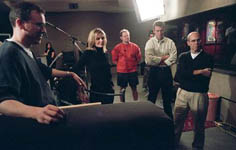
Katzenberg: Spike challenges him.
What's the biggest difference between live action and animation?
Pitt: Who's going to say it? I'll say it. The hours. They're much shorter. It lets you have a life....It was a much more relaxed atmosphere. There aren't hundreds of people and millions of dollars ticking away with the moves you make.
Haysbert: I love how you can get that banter when you're not even speaking to the guy you're supposed to be speaking to. A lot of the credit has to be given to the writers and the person you're reading with.
Katzenberg: I don't think enough credit is given to the value that actors and actresses bring to these movies. They're all being humble, but it's about finding a character. It's no different in live action. Look at what Michelle created for that character. I don't know if you remember, but the day she absolutely nailed it was the day she wore a very long scarf for some reason.
Pfeiffer: I was freezing.
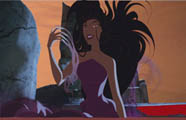
Katzenberg: There was something about taking that scarf and throwing
it around that got you in this place to be in character.
Pitt: For me, it's nudity [he deadpans]....I don't completely understand that either. I mean, you guys will go, "Great performance," and I go, "We didn't do anything, we just showed up here."
Katzenberg: The thing I don't think any of you realize is that your voice is you. It is literally the essence of who you are. It's a combination of your voice and the physical manners that you have, the animators capture that, and they put it into these creations. Sinbad doesn't look anything like you, but if you put him into motion and let him start talking it can capture the essence of you as an actor.
Haysbert: That was the most startling thing, because I forgot about that little video recorder in the corner.
Pitt: They're sneaky now, aren't they?
Haysbert: You can't see it. Your imagination takes over. You don't have any inhibitions about what you're doing physically. In one scene where I'm upset with his character for what he's about to do to his buddy, I do something I always do when I get frustrated, I roll my eyes. It's this thing my kids do that drives me nuts. I saw it in the cartoon, and I thought, "That's me!"
Pitt: I'm amazed at the specificity and facial expressions these guys
get. There's better stuff in there than I can do on my own.
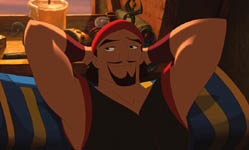
Was Jeffrey a tough taskmaster? Did he give you specific direction
on your voices?
Pitt: He pretty much let us run, then everybody would get involved, which is a fun jam session with the directors and Jeffrey.
Pfeiffer: It's all mixed up. It starts out imitating Jeffrey ...
Pitt: ... and ends up that way too.
Katzenberg: They're just getting even with me.
Pitt: That's not true! I got some of my best line readings with Jeffrey. On the ones where I took 20 shots and just couldn't quite find that little zing.
In a world where image is everything, what's the attraction of doing something where you're invisible?
Pfeiffer: That. It's liberating. It takes the pressure off. You can experiment in a way you can't when there's pressure on.
Katzenberg: We were really happy with what she did for us. When the
movie was two-thirds done, enough so she could see the whole movie from
beginning to end and really understand it, she said, "I could beat those
lines all over the place."
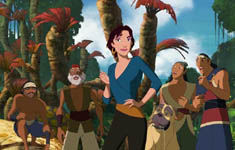
Pfeiffer: I think initially they were humoring me. I think you guys
were happy with it because we have a relationship. They let me go in and
redo it so that I could feel as an artist I had done everything I had wanted
to do.
Katzenberg: Eris has 75 or 100 lines in the movie. Of them, there were 22 she said she would make better. We ended up replacing 17 of those. She did do stuff that was just better. And we reanimated a bunch of it.
How did you calibrate the humor level?
Katzenberg: We tried to make it work on two levels.... There's a very sophisticated level of wit and humor in it, a lot of which goes over the heads of the kids.
How old should they be before they see this film?
Pitt: I'm the wrong one to ask. I tried to take my godson to "The Two Towers." It was a disaster. He was about 5. It was with his mom's permission.
Katzenberg: "Sinbad" is not for 3- or 4-year-olds. It is a PG-rated movie. Some of the action gets intense.
But there's no violence in it. No blood.
Pfeiffer: Also, some kids don't mind that.
Pitt: That was my kind of movie when I was a kid.
Katzenberg: We've put this in front of half a dozen audiences. We made adjustments along the way. There were two things that were too suggestive sexually....Some parents didn't like Proteus saying, "Stick around, there's going to be a helluva party." We found another take saying "one heck of a party," and it was just as good, so we changed it....We discovered how much the kids love Spike. We went back and put seven new pieces of Spike in the movie only weeks ago.
For big-name actors, what kind of a career move is it to appear in an animated film?
Pfeiffer: I'm not sure it's a career move one way or another. First of all, because I hate my voice.
Pitt: Me too.

Pfeiffer: I'm always shocked that they think it's recordable.
Pitt: It's a gorgeous voice.
Pfeiffer: Thank you. I'm flattered that they think of me, because there are so many people to choose from and almost everybody would say yes.
Haysbert: For me, it's the audience you reach. It's a lot different from the audience you reach in a live-action movie. Even for the audience that normally watches you, they get to see you in a different light. Or hear you in a different light....You work for the idea of it becoming a sequel. For the love of it, really. And for my kids. They're 8 and 12.
Pitt: For me, it's just about trying something new. I've got nieces
and nephews; I get addicted to the little brats. I want to give them something
back, I guess.
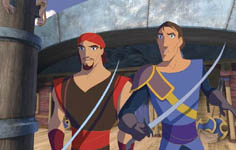 |
 |
 |
 |
Reproduced from DreamWorks
SKG Fansite.
SETTING SAIL
For generation after generation, the name Sinbad has evoked images of swashbuckling adventures on the high seas. Born more than a thousand years ago in the ancient tales of The Arabian Nights, Sinbad has come to the big screen before, most notably in Ray Harryhausen’s cult classic stop-motion animated films. However, the state-of-the-art tools of today’s traditional animation have allowed Sinbad to be brought to the screen as never before in "Sinbad: Legend of the Seven Seas."
Producer Jeffrey Katzenberg offers, "Sinbad is one of those epic hero
characters we all grew up with, but his story has never been told in animation,
and the opportunity to do something fresh, with a contemporary sensibility,
was very exciting. Telling the Sinbad tale also allowed us to create an
incredibly breathtaking world full of fantastic monsters. That’s the fun
of animation—to take an audience to places unlike anything they’ve ever
seen before."
To craft the script, the filmmakers turned to a writer who was no stranger
to bringing epic heroes of the past to the screen: John Logan, the writer
of the Oscar®-winning Best Picture "Gladiator."
"After the phenomenal success of ‘Gladiator,’ we thought, who better to adapt the legend of Sinbad?," says Katzenberg. "John set out to take this rich mythology and reinvent it in a way that would make it a compelling story for a 21st-century audience, and I think he really accomplished that for us."
Having never worked on an animated film before, John Logan recalls that
he was intrigued by the story possibilities, but at the same time admits,
"I had no idea what to expect. Jeffrey Katzenberg—who, by the way, is quite
the con man—asked me if I would like to write an animated movie. I said,
‘Well, I really don’t know much about it.’ He assured me, ‘It’s really
fun; you’ll have a great time doing this,’ knowing full well the ‘fun’
would take four years of my life," Logan laughs.

"But I must say, it was incredible fun," the writer continues. "I grew
up on those classic Sinbad movies with Ray Harryhausen’s stop-motion animation
monsters, and I have always loved pirate movies with all that swashbuckling
action. What guy doesn’t? So to get to play in that realm for a while was
really exciting. Animation is also incredibly liberating because it gives
a writer absolute freedom to explore the most fantastical worlds. In live
action, there’s always a nagging thought in the back of my mind that if
I write that 10,000 soldiers come over the hill, somebody has to cast them,
somebody has to wardrobe them, somebody has to shoot them, and there has
to be a hill. But in animation, if I write that a 100-foot sea monster
rises from the waves and jumps over the ship, I know it can happen."
Logan also appreciated the level of teamwork that comes with working on an animated film, saying, "I was the beneficiary of some incredible talents because the act of writing ‘Sinbad’ was actually one of collaboration with the producers, directors, animators, story editors, artists, the voice talent… It was like electricity in that room; wonderful things emerged as we all tried different takes on the material."
Producer Mireille Soria notes, "We started with the Sinbad legend and then brought in different elements of mythology that we felt worked with the story. There is action and romance, but at its core is a tale of friendship based on the Greek fable of Damon and Pythius, about one friend who is willing to sacrifice his life for the other."
Director Patrick Gilmore expounds, "We cast a really wide net out to
different mythologies to find what we thought were the greatest adventures
and the coolest monsters to test our hero, but the thread that runs through
the story is a test of friendship. In our story, Sinbad is reunited with
his friend Proteus after having been estranged for about 10 years. Yet,
when Sinbad gets into trouble, Proteus steps forward and puts his own life
on the line for his old friend. What will Sinbad—this thief who is used
to having the freedom to do anything he wants in life—do? Will he run for
the horizon, or will he risk his life for his friend?"
CAST ON
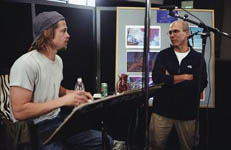 Brad
Pitt gives voice to the title character of Sinbad, or, the actor jokes,
"as I like to call him, Sin-Brad." Pitt goes on to describe his character
as "a bit of a rogue. He lives a life of adventure on the high seas. He
finds a little treasure, fights a few monsters…and he likes the girls."
Brad
Pitt gives voice to the title character of Sinbad, or, the actor jokes,
"as I like to call him, Sin-Brad." Pitt goes on to describe his character
as "a bit of a rogue. He lives a life of adventure on the high seas. He
finds a little treasure, fights a few monsters…and he likes the girls."
Director Tim Johnson states, "Casting Brad Pitt as Sinbad was a home
run for us. He’s funny, he’s charismatic, he’s dashing, and with him at
the helm of this character, we had a blast."
"He fit the role of Sinbad to a T," Gilmore adds. "Brad is charming and witty and fun to be around. He’s the sort of guy you’d want to go on a road trip with, and that’s what we wanted in Sinbad. Sinbad is smart, resourceful and physically strong; he can get you out of any jam. But at the same time, he’s got some growing up to do. Brad carried that off really well."
Jakob Hjort Jensen, who served as the lead supervising animator for the character of Sinbad, offers that Pitt gave him more than a vocal performance with which to work. "Brad has specific body movements, and he talks a lot with his hands. It was fun to watch him do lines and observe things he’d do with his hands that I could maybe use. I did little thumbnail sketches so I could remember his gestures four or five months later when I was animating that particular scene."
Making his first foray into animation, Pitt surprised even himself with the physicality of recording the voice of Sinbad. "I really got into it. I would get home and actually be sore. But even though I wish I could take credit for it, I have to say that so much of the character was in the hands of Jakob and the other animators. I was blown away by the detail they can put into a facial expression and the dynamics of the movement. What they can do with animation these days is pretty remarkable."
"Animators are a rare and talented breed," Johnson agrees. "When an animator is watching a performance, he is not only listening to the voice; he is looking for those key gestures that an actor uses to sell a line and then takes them and makes them bigger. It’s a meticulous and magical process. Jakob was able to incorporate ‘Bradisms’ that are central to who Brad is and make him so recognizable, so even though Sinbad doesn’t look like Brad Pitt, boy does he move like him."
Sinbad and his crew have plundered their way across the seven seas, but now Sinbad is going after the most powerful and priceless treasure of all—the Book of Peace. Unfortunately for him, someone else has her eye on the same prize: Eris, the mischievously evil goddess of chaos, whose joy in life is to wreak havoc upon the world.
John Logan remarks, "Any writer worth their salt is going to tell you that the most fun character to write is always the villain. Eris certainly was for me because you can never go over the top with a goddess or a great villain, and when the villain is a goddess, it’s just endless fun."
 Michelle
Pfeiffer, who provides the voice of Eris, was eager to share in the fun.
"All they had to say was ‘the goddess of chaos,’ and I said ‘yes,’" she
laughs. "I wasn’t trying to create a villain; I wanted her to be playful.
She just relishes stirring up trouble to make things interesting and amusing
for herself…like her own reality TV. If it’s too peaceful, it’s terribly
boring to her. The whole thing starts out as a game where she is pretty
sure what the end result will be because she is convinced that man is weak.
She’s just toying with Sinbad, like a cat batting around a mouse."
Michelle
Pfeiffer, who provides the voice of Eris, was eager to share in the fun.
"All they had to say was ‘the goddess of chaos,’ and I said ‘yes,’" she
laughs. "I wasn’t trying to create a villain; I wanted her to be playful.
She just relishes stirring up trouble to make things interesting and amusing
for herself…like her own reality TV. If it’s too peaceful, it’s terribly
boring to her. The whole thing starts out as a game where she is pretty
sure what the end result will be because she is convinced that man is weak.
She’s just toying with Sinbad, like a cat batting around a mouse."
Taking her cue—and adding a reference to one of the actress’ most memorable roles—Gilmore states, "Eris is Catwoman with a god complex. She is a combination of seduction and magic and fun and games, and Michelle put that all together beautifully."
Katzenberg, who had worked with Pfeiffer on DreamWorks’ first traditionally animated feature, "The Prince of Egypt," notes, "I don’t believe there is another actress in the world who could mix all of those amazing characteristics together better than Michelle. I also think the character of Eris was more challenging because she was not rooted in any physical embodiment that an actor could relate to. It became a collaborative process of discovering the character along the way. Michelle didn’t just come in and read the lines; she really helped invent the character."
Gilmore reveals, "Very early on, we talked about Eris being a product of her own thought, meaning that she could think about something and become that thing, or think about moving someplace and she’s instantly there. She morphs, she twists, she changes shapes…"
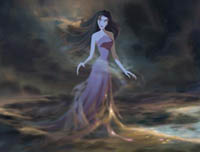 In
a remarkable showcase of what can be accomplished by traditional animators,
Eris’ constant shape-shifting was achieved entirely with the tools of 2D
animation. The supervising animator for Eris, Dan Wagner, says that, in
spite of the challenges it posed, "The morphing was the most fun part of
animating Eris. This was pure animation. Once I got into the morphing,
there were no model sheets to follow and no boundaries. It was just having
fun."
In
a remarkable showcase of what can be accomplished by traditional animators,
Eris’ constant shape-shifting was achieved entirely with the tools of 2D
animation. The supervising animator for Eris, Dan Wagner, says that, in
spite of the challenges it posed, "The morphing was the most fun part of
animating Eris. This was pure animation. Once I got into the morphing,
there were no model sheets to follow and no boundaries. It was just having
fun."
Wagner’s approach to animating Eris became the equivalent of animating two characters, as he treated her long, flowing hair as a separate entity. "The hair was like a second character," Wagner attests. "First I would animate Eris without her hair, and once that was going pretty well, I’d add the hair on top. I wanted her hair to have a kind of underwater feel to it. Her body would be zipping around, but her hair might be doing its own thing. It showed another dimension to her character, though it had to be secondary because the focus should stay on her face."
Eris not only represents the best of hand-drawn animation, but also how far animation has come in the seamless blending of 2D, or traditional, animation and 3D, or computer, animation. The character is decidedly ethereal, constantly floating in space and never touching down on what mere mortals call legs. To help give Eris that otherworldly appearance, her face, body and hair were traditionally animated, while the end of her body materializes in wisps of smoke that were rendered in 3D animation.
Effects supervisor Doug Ikeler explains, "Eris is a hand-drawn character, but we wanted to integrate her into her environment, so we used a package called Paint Effects to give her those 3D smoky trails. It was difficult because 2D is flat—it’s drawn on a piece of paper—while, by definition, 3D has depth, so the character and the wisps of smoke that follow her are residing in two different spaces. We cheated it to make it look like they exist in the same realm, but as she touches down, the ensuing mist is able to spread out and go back in space, so that part is full-on 3D."
When, for reasons of his own, Sinbad decides not to steal the Book of Peace, Eris takes matters into her own hands. Peace is the last thing she wants, so she takes the book herself, framing Sinbad for the crime in the process. Sinbad’s protestations of innocence fall on deaf ears and he is condemned to death, but to everyone’s shock, Prince Proteus intervenes on Sinbad’s behalf. Despite all evidence to the contrary, Proteus trusts Sinbad to risk his own life to find and return the precious book in time to save the prince’s life.
 "Proteus
is a man who takes his responsibilities very seriously," says Tim Johnson.
"He is the Prince of Syracuse, and when he is faced with the greatest disaster
the city has ever known—the theft of the Book of Peace—he feels it is up
to him to solve the problem. He is the only one who believes in Sinbad’s
innocence, but he also knows that Sinbad is the only one who stands a chance
of recovering the Book of Peace."
"Proteus
is a man who takes his responsibilities very seriously," says Tim Johnson.
"He is the Prince of Syracuse, and when he is faced with the greatest disaster
the city has ever known—the theft of the Book of Peace—he feels it is up
to him to solve the problem. He is the only one who believes in Sinbad’s
innocence, but he also knows that Sinbad is the only one who stands a chance
of recovering the Book of Peace."
Johnson adds that Proteus’ almost too-good-to-be-true nobility made him a hard role to play, but casting Joseph Fiennes in the part gave it just the right balance. "Proteus is so noble and true, he could easily have come off as flat, but Joe did an amazing job. He brought a dynamic to Proteus that conveys how he wrestles with every decision. You understand that this is not a guy who immediately and easily makes the noble choice. He is somebody who understands how much sacrifice is sometimes involved in doing the right thing."
Joseph Fiennes agrees that Proteus struggles with the duties of his position, which must preclude his own love of adventure. "I can’t help but feel that deep down, if Proteus didn’t have his royal obligations, he would love to join Sinbad out on the high seas as a pirate," he observes. "There is probably this yin and yang within him—this urge to be everything that Sinbad is…everything their boyhood friendship was based on. There is a great history between these two; they have a wonderful relationship, built on all the dynamics of being best friends at a young age. They spark off each other, and while they can be very argumentative, you realize that there is a great trust and a great love between them."
Proteus’ regal calling in life also influenced how supervising animator Rodolphe Guenoden drew the character. "We had to differentiate between how Sinbad and Proteus moved and expressed themselves," Guenoden says. "Proteus was formally educated and trained from birth, so he is very restrained and very proper. I had to pull back from any spontaneous gestures or mannerisms, and make very precise and articulate moves. That was the toughest job because, as an animator, you want to do more, but with Proteus, less is more. Joseph Fiennes made my job easier because he is such an intense actor and very classically trained, so the acting was already there. I just had to follow the path."
Fiennes counters that the inspiration for the character worked both ways. "You are given such wonderful insight into the character through the vision of the artists. This was my first venture into the territory of animation, and I was wildly excited by the opportunity. The sheer imagination that went into creating the world they were asking me to step into… What actor could turn that down? The detail of the craftsmanship was mind-boggling; it gave me goose bumps. I have such respect for the people who draw these characters over a period of years. It’s an extraordinary task."
As it turns out, Proteus’ trust in Sinbad might have been misplaced.
However, his fiancée, Marina, the Ambassador of Thrace, has no illusions
about Sinbad, and her instincts pay off. Instead of setting a course to
Eris’ lair in Tartarus, Sinbad turns his ship, The Chimera, towards Fiji
for a permanent shore leave, unaware that he has an uninvited guest aboard:
Marina has stowed away and has no intention of allowing Sinbad to desert
her intended.

"Marina is extremely strong-willed, which is very challenging to Sinbad,"
Gilmore says. "Sinbad considers himself the master of the seven seas and
is used to being in total control of everything on his boat. All of the
sudden, his world is turned upside down when he is confronted by this headstrong
woman who is unafraid to stand up to him and is more than capable of going
toe-to-toe with him. It’s fun to watch these two tangle and see the sparks
fly."
Catherine Zeta-Jones, who provides the voice of Marina, agrees. "Marina is feisty and very opinionated, so she and Sinbad are equals, while coming from very different places. The banter between them was so much fun to play because it was not your usual princess-meets-rogue dialogue. Marina gives as good as she gets. They have a very funny relationship because, in Sinbad’s mind, she’s not supposed to say and do the things she actually says and does."
"Catherine was the first voice talent cast for this picture, and she just blew us away with her performance," Johnson states. "We really based the whole character, dialogue and design of Marina on being fortunate enough to have Catherine in the role."
Zeta-Jones says that her own upbringing helped her identify with her character, noting, "I grew up in a family of boys and heard many times about what girls can’t or shouldn’t be doing. But I have always been a little feisty myself, and believed that girls can do things just as well as boys, so I related very much to Marina. I hope young girls and women of all ages enjoy Marina as much as I enjoyed playing her. She’s bright and funny and honest and strong…things I hope to instill in my own daughter."
Catherine’s affinity for her role also benefited William Salazar, the supervising animator for Marina. "Catherine’s voice really captures Marina’s spirit and determination," Salazar says. "I was inspired by her acting and used some of her movements and poses to show Marina’s attitude."
Much to Sinbad’s consternation, Marina quickly proves her mettle and wins the favor of the crew, even earning the respect of Sinbad’s loyal first mate Kale, voiced by Dennis Haysbert.
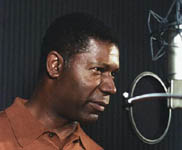 "Kale
is Sinbad’s first mate," Haysbert says. "He makes sure the crew follows
orders. If there were any kind of mutiny in the air, I think one look from
Kale would squelch it. But he has multiple job descriptions: He is a warrior
supreme with whom you would want to go into battle; he is the friend Sinbad
can count on to watch his back; and he also acts as Sinbad’s conscience
to rein him in when he gets too ‘out there.’"
"Kale
is Sinbad’s first mate," Haysbert says. "He makes sure the crew follows
orders. If there were any kind of mutiny in the air, I think one look from
Kale would squelch it. But he has multiple job descriptions: He is a warrior
supreme with whom you would want to go into battle; he is the friend Sinbad
can count on to watch his back; and he also acts as Sinbad’s conscience
to rein him in when he gets too ‘out there.’"
Brad Pitt acknowledges, "Here is the problem: Sinbad’s got a bit of
an ego, and sometimes that ego gets in the way. So he has Kale as his right-hand
man to keep him on the straight and narrow."
"I cannot say enough about what a delight it was to have Dennis in the role of Kale," Patrick Gilmore comments. "When we first started working on the story, Kale was sort of a yes man. He did whatever Sinbad needed. Then Dennis came aboard and played Kale as Sinbad’s conscience—that little voice that challenges Sinbad to do the right thing, to do right by his friend Proteus, as well as Marina. Dennis gave so much spirit, nobility and confidence to the character that Kale’s role was actually expanded. There were whole scenes written for him based on what Dennis brought to the part."
As the character evolved, the filmmakers and supervising animator Bruce
Ferriz modified the overall design of Kale to better fit Haysbert’s portrayal.
Gilmore explains, "Kale was always a big, strong guy, but once we started
listening to Dennis’ voice, we made changes to the character, mostly in
how he moved. Kale doesn’t jump into a fight and spring around defending
himself. He just walks right into the middle of it and calmly and politely
relieves people of their weapons, leaving a trail of unconscious bodies
behind him."
Another member of the crew who takes an instant liking to Marina is
Rat, who, in contrast to Kale, is small and wiry and more at ease swinging
from the crow’s nest than standing on the deck. Rat is voiced by Adriano
Giannini, the son of legendary actor Giancarlo Giannini. Tim Johnson says,
"Adriano came in with so much energy. Even performing at a microphone in
a cold room, he made me feel like he was swinging from mast to mast or
hanging upside down to confront Sinbad."
 No
matter what, Sinbad knows he can at least count on the loyalty of man’s
best friend: his beloved dog Spike. Well, maybe not, says Johnson. "Spike
has been by Sinbad’s side through all his adventures, but when the beautiful
Marina shows up, even he can’t help but find her pretty special. In a way,
Spike plays matchmaker for the two of them in the picture."
No
matter what, Sinbad knows he can at least count on the loyalty of man’s
best friend: his beloved dog Spike. Well, maybe not, says Johnson. "Spike
has been by Sinbad’s side through all his adventures, but when the beautiful
Marina shows up, even he can’t help but find her pretty special. In a way,
Spike plays matchmaker for the two of them in the picture."
"Spike and Marina have a wonderful relationship," Zeta-Jones smiles. "The idea of sharing a bunk with him isn’t too nice at first, but they develop a great friendship that grows and grows—much like Spike’s part. Spike has taken over the movie," she teases. "As actors, we’re none too pleased with him. It’s hard to compete with such a charismatic animal. In fact, I ran into Brad Pitt recently and told him that I want to do another movie with him where we don’t have to compete with Spike."
The filmmakers put a lot of thought into what kind of dog a character like Sinbad should own. Gilmore relates, "At first, Spike was a well-groomed Akita-type dog…very pretty. But we took one look at the design and said, ‘No, that’s not Sinbad’s dog.’ We went back and found the American Kennel Club description of a bull mastiff. They are huge and powerful. I mean, these are dogs that fought elephants. We said, ‘Okay, that’s the kind of breed Sinbad would have.’"
While it only took one actor to voice each of the human characters, it took no less than eight dogs to play Spike, and both directors agree the "dog days" were the funniest on the recording stage. Johnson recalls, "Those were probably the wildest and most unpredictable days in front of the microphone. We had dogs of all shapes and sizes to voice Spike, because there were all these acting moments that we needed. In some ways, Spike has more lines of ‘dialogue’ than some of the humans in the film. So it took eight dogs, four hours, and a whole lot of bowls of water to get what we needed for our one dog Spike, mostly because some of the better takes were destroyed by our own laughter."
"Any trained dog can bark on command," Gilmore expounds. "It’s the grumbles, it’s the mutters, it’s all those sounds that bring the character to life. And you should have seen the tricks we pulled on those dogs to bring Spike to life: We put mayonnaise on plates to get those wet, drooly, licking sounds; we showed them a toy and then held it back to get those frustrated whines… It was basically sitting in a recording room playing with dogs to get the wide variety of sounds that Spike makes. But it was important, because from the moment we decided Sinbad was going to have a dog, we knew we wanted it to be a real dog—not a cartoon sidekick, not a dog voiced by a human, but a real dog. Spike does a lot of cool stuff in the movie, but it’s stuff a real dog could conceivably be trained to do, if he belonged to someone like Sinbad."
Amongst the canine ensemble cast as Spike, there was one dog that took the lead in both voice and mannerisms: Harvey, a bulldog with a face only an animator could love. A veteran of such films as "Batman" and "I Love Trouble," Harvey is trained by renowned animal trainer Boone Narr, who says, "I got the call that they were looking for a dog with an unusual ‘voice,’ and we knew that had to be Harvey. We took him down to the recording stage, and Harvey stole the show. He has several pitches of barks, and when you scratch his stomach, he makes these guttural snorty sounds. I’d say he’s the Marlon Brando type—he only says a few words, but when he says them, it means something," Narr laughs.
Narr relates that audiences will also see some of Harvey in Spike, as
the animators, led by Serguei Kouchnerov, incorporated a number of the
bulldog’s expressions to go along with his "voice." "They really captured
his curiosity—the way his head tilts…things like that. So even though several
dogs went into creating Spike, the main part of him is Harvey."
CREATURES GREAT & SMALL
Sinbad is not the only one with a pet. Eris has her own menagerie of creatures, although they are hardly what you would call tame. The goddess often dispatches them to instigate the chaos she lives to create.
The inspiration for Eris’ monsters came from the night sky. Many of the constellations were born of mythology, so in turn, the filmmakers made them part of the Sinbad mythology. Johnson, a self-proclaimed "astronomy nut," remarks, "To bring these astronomical icons to life as creatures that a goddess could call her ‘pets’ was an exciting way to have some fun with the character while hinting at her power."
Gilmore illustrates: "The constellation Cetus became our sea monster; Aquila inspired our giant bird of prey called the Roc. You see Scorpius, you see Draco… They are all part of Eris’ cosmic realm of chaos."
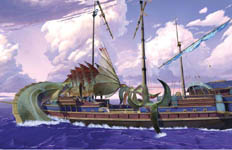 The
gigantic sea monster is the first of Eris’ "pets" to confront Sinbad, and
the computer-animated creature posed almost as big a challenge to the CGI
animators who had to manipulate it. The sea creature had a myriad of moving
parts—a head, a tail, tentacles, ears, legs, a tongue, and more—all of
which had independent controls, making it exceedingly complex.
The
gigantic sea monster is the first of Eris’ "pets" to confront Sinbad, and
the computer-animated creature posed almost as big a challenge to the CGI
animators who had to manipulate it. The sea creature had a myriad of moving
parts—a head, a tail, tentacles, ears, legs, a tongue, and more—all of
which had independent controls, making it exceedingly complex.
The computer-animated snowbird called the Roc presented a different set of challenges. Not only does it appear the size of a commercial jetliner, the Roc also generates a perpetual snowstorm in its wake. Doug Ikeler, the 3D effect supervisor, notes, "Wherever he flies, a snowstorm follows, but it couldn’t look like falling snow; it’s snow that’s caught up in the vortex caused by his flapping wings. It has a hand-drawn, swirly quality to it, so it was a very large effect for us."
The Sirens, while hardly monstrous in appearance, were among the most dangerous creatures faced by Sinbad, Marina and the crew of The Chimera, and among the most complicated to animate. Johnson offers, "Sirens are the mythological women who sing songs that entrance sailors and cause them to crash on the rocks and drown. We wanted our Sirens to feel unearthly and derived purely from water. We went through a lot of development to take animated female figures and turn them into essentially living fountains. When they rise out of the water, they splash up like a wave, float in the air, and then fragment into a million drops of water as they try to sweep the men off the deck of the ship."
To choreograph the graceful movements of the Sirens, the 3D animators, led by Michelle Cowart, studied the moves of rhythmic gymnastics, ballet and modern dance. They also looked at underwater photography to depict the fluidity of the seductresses. The initial 3D characters looked more like naked silver plastic women until the effects department took over. The effects team used particle systems to create flowing drapes of water that gave the Sirens their liquid appearance.
The Sirens’ hair, which enhances their ethereal quality, took the longest to animate. Every Siren had 16 strands of hair, each of which had a minimum of seven separate controls to manipulate its shape. The problem was that even when the animators got the individual strands moving beautifully, they didn’t always move beautifully together, resulting in the character looking more like Medusa than a Siren. In addition, the animators didn’t know exactly what the end result would be after the effects department completed the look, so there was a lot of going back and forth between the departments and starting over again to get it right.
After eluding the Sirens, Sinbad and Marina find no respite even on what appears to be a small tropical island. The small island is actually a big fish that would dwarf even the largest whale. During an exciting escape sequence, Fish Island ends up with The Chimera in tow, taking the crew on a wild ride that tests the fortitude of even the most experienced seafarer.
Doug Ikeler describes, "This relatively tiny boat is being dragged behind a fish that’s thousands of feet long, which generates this gigantic wake behind it. The boat is caught in the wake, making it do these wave-boarding moves. We had to render huge splashes and the white water that you would associate with those enormous wakes, as well as the mist to give it scale. It was probably a 50-layer scene for us, because we had to create all the things that make water look like water."
The advancements in animation notwithstanding, animating water still poses tremendous challenges. True to its title, "Sinbad: Legend of the Seven Seas" is set on the ocean, and when a story takes place almost entirely on the water, the demands increase exponentially.
Patrick Gilmore notes that, with the help of DreamWorks’ preferred technology provider Hewlett-Packard, the effects department developed an ingenious way to expedite the process. "Rather than compose the ocean per shot, what they decided to do was build an entire ocean and have it run procedurally. It was our ability to have this entire rolling ocean at our disposal that made it possible to do as many water shots as we needed in the film."
Ikeler explains, "We needed a way to put the ocean in almost every scene
of the movie, so we devoted a lot of time to coming up with software that
would give us a kind of plug-‘n’-play ocean library. Once we had our ocean
simulation, we just let it play for about 1,000 frames, which gave us our
ocean on a grand scale. We then told everyone, ‘It’s done; it’s baked.
Your ocean is playing. Go put a camera on it and shoot it from whatever
angle you need to.’ The layout department could then take the base shape
of the water, fly a camera around it, and compose their shot with an already
produced ocean. Once they had their basic composition, we came back in
and laid in all the elements that went with that particular location."
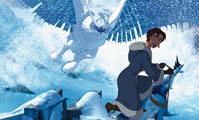
The layout department also benefited from the unprecedented use of
computer models of scene elements, called animatics, to camera block the
entire movie in 3D. While animatics are not new to animation, no other
film has ever been pre-shot from start to finish utilizing them. Layout
supervisor Damon O’Beirne offers, "Animatics basically allowed us to build
a scene in the computer in 3D. What’s great about them is you can play
back a scene in real time, which provided us a great template for the action.
There are a number of big action sequences in ‘Sinbad,’ and working with
animatics gave us the opportunity to explore the best camera angles to
drive those sequences and to create a strong cinematic style for the movie.
With animatics, we can even shoot coverage, which enabled us to give extra
scenes to the editor, who can then pick and choose."
Editor Tom Finan adds, "It helped a great deal. In the past, we cut from storyboard sketches. But now, with animatics, you can see camera moves in advance and even how the characters move within a shot, which you couldn’t get with storyboards. Being able to edit from moving images is much more like cutting live action."
Innovations in animation have been coming so rapidly that filmmakers have been able, in essence, to "put the cart before the horse" with regard to technology. Jeffrey Katzenberg attests, "Unlike any movie I’ve worked on before, on ‘Sinbad’ the technology had to catch up with our ambition for the film, as opposed to the other way around."
Johnson agrees, "‘Sinbad’ was more than three years in the making, and
when you’re planning something that far ahead of its release, you have
to take a leap of faith that, with moviemaking advances, we would be able
to do what we had only imagined. We didn’t know how we were going to do
it, but we knew we had the time and some incredibly talented people to
figure out how to pull it off."
FANTASY WORLDS
The filmmakers utilized some advances in animation in the design of
Tartarus, the home of Eris, which lay beyond the edge of the world. Depicted
as an ever-shifting ocean of sand, Tartarus was realized as a result of
an ongoing collaboration between the production design and effects teams.
Production designer Raymond Zibach says, "Tartarus presented a huge
challenge in how to show the land of chaos where Eris resides. We went
through multiple versions until Tim Johnson came up with the idea of sand
that would be animated like water—this chaotic terrain that you can stand
on but not control."
Ikeler expounds, "We rendered waves of sand that move like waves on the ocean, and as they rise and fall, they reveal the ruins of ancient cities. We had to do a lot of particle effects that come with having sand blowing across the surface or trickling down the face of whatever is revealed when the sand recedes."
The main set of the film was The Chimera, the ship that carries Sinbad, Marina and their crew from one adventure to the next. Zibach and co-art directors Seth Engstrom and David James had a great deal of fun with the design of the ship, as well as its clever gadgets, which, for the design team, made The Chimera a character in the film.
"The Chimera is more than a ship; it is a wonderful tool at Sinbad’s disposal," Zibach states. "The main objective was to make it simple but bold in its shape and then build on it without getting too sci-fi—to keep it within the period that the story takes place."
The beautiful ancient city of Syracuse was intentionally designed not to reflect any one culture. John Logan notes, "The legend of Sinbad has been reinterpreted many times, so in exploring elements of the different tales, we created a wholly fantastical world in which to put our Sinbad. We wanted to create a world of men and monsters—a place where myth could be made real—so we kept it away from actual places and created a Syracuse of the imagination, relating not at all to the Syracuse in Italy…or Syracuse, New York, for that matter."
 Mireille
Soria offers, "We wanted our Syracuse to combine the romanticism of Venice
and the exoticness of Damascus, so Raymond, Seth and David did a lot of
research through art and architecture. They brought in the flavors of the
Middle East, Greece and Italy, and then shook them up to make the setting
original and new."
Mireille
Soria offers, "We wanted our Syracuse to combine the romanticism of Venice
and the exoticness of Damascus, so Raymond, Seth and David did a lot of
research through art and architecture. They brought in the flavors of the
Middle East, Greece and Italy, and then shook them up to make the setting
original and new."
The musical score, composed by Harry Gregson-Williams, was another aspect of the production that incorporated a blend of cultural influences. "The core of the music is orchestral, but it’s not necessarily traditional," Gregson-Williams remarks. "The setting of the story is unspecific, which gave me license to use a smattering of different ethnic instruments."
Gilmore says, "We went to Harry specifically because we had created this fantasy world for ‘Sinbad,’ and it needed a musical voice that wasn’t familiar. After having scored movies like ‘Shrek,’ ‘Chicken Run’ and ‘Antz,’ he is used to composing for worlds that don’t exist. Harry delivered an amazing musical journey to accompany Sinbad’s adventures. He created this fully orchestrated score, with ethnic sounds to make it feel exotic and fantastic, but contemporary in its arrangements."
That approach fit in perfectly with the filmmakers’ goals for "Sinbad: Legend of the Seven Seas." "We really wanted to take Sinbad, this fabulous adventure character from the past, and bring him to a 21st-century audience," Johnson comments.
Brad Pitt believes the film’s appeal will also transcend age groups, remarking, "I love this film; it’s fantastically fun. I originally thought of doing it for my nieces and nephews, but even now, as an adult, this is my kind of movie. What the filmmakers went after was a movie that everyone could get something out of, and I think they truly pulled it off. Since parents usually end up seeing a film over and over with their kids, it’s nice that they can enjoy it, too."
John Logan reflects, "All of the old Sinbad stories and movies have that swashbuckling fun to them, and certainly we tried to capture that joy of adventure in our Sinbad. But what surprised me about this movie is how adult it is. It has all the freewheeling fun of an animated movie, but at its core there is this romantic story about how this man discovers his better self."
Katzenberg agrees, "Through all his adventures, Sinbad learns that there
are some things you can’t escape. When it comes to love or even a great
friendship, you can run, but you can’t hide. It stays with you, which is
a powerful lesson to learn."
|
||||||||||||